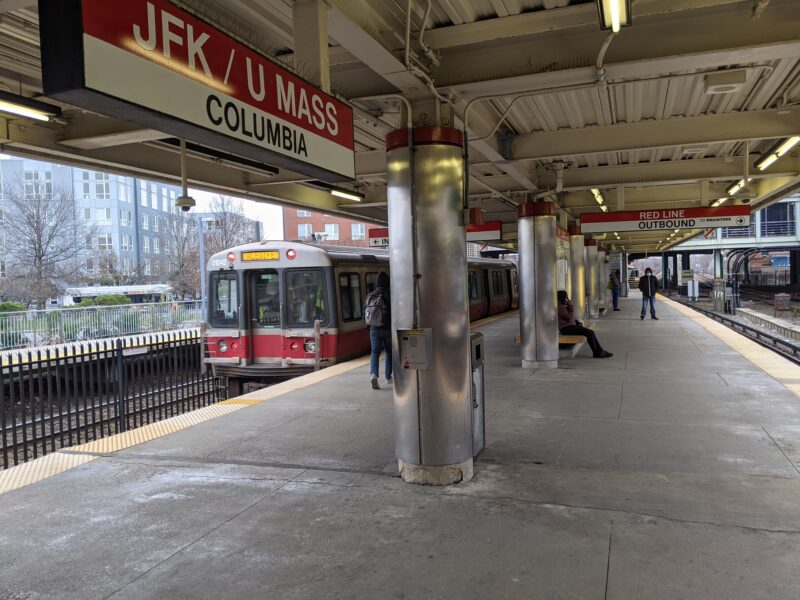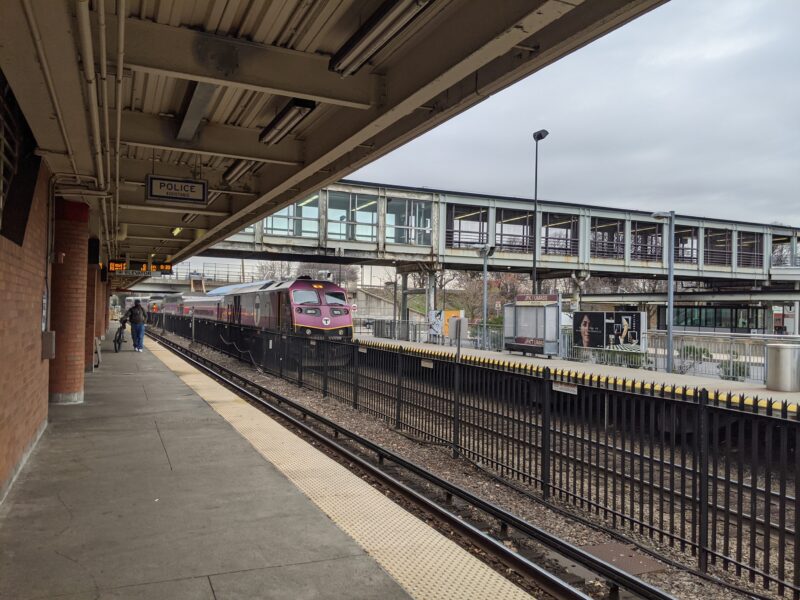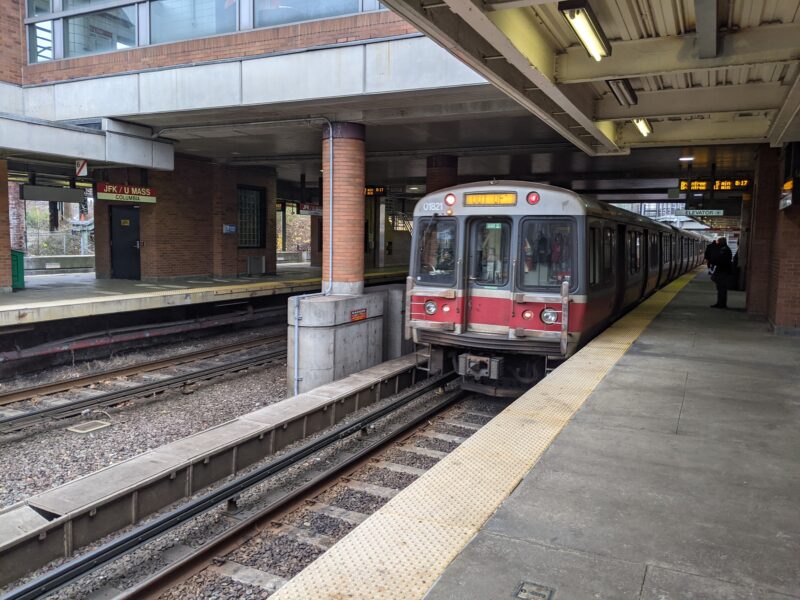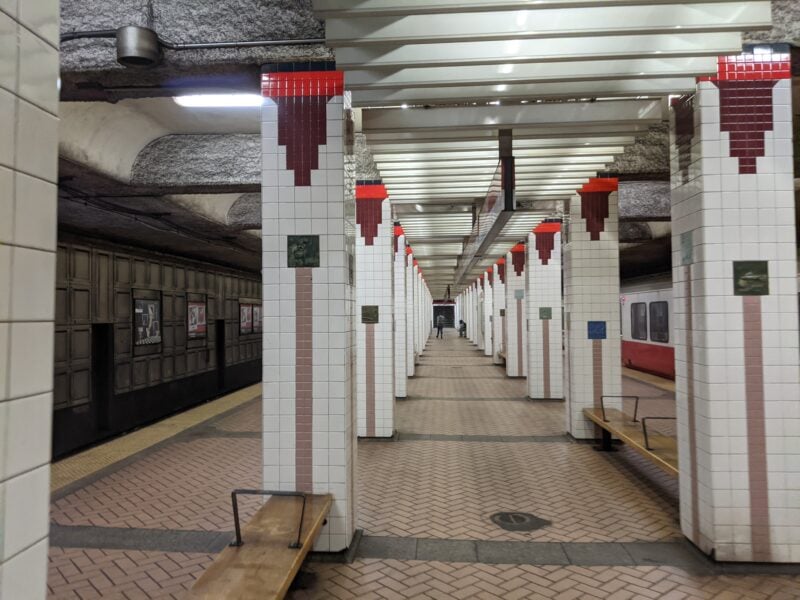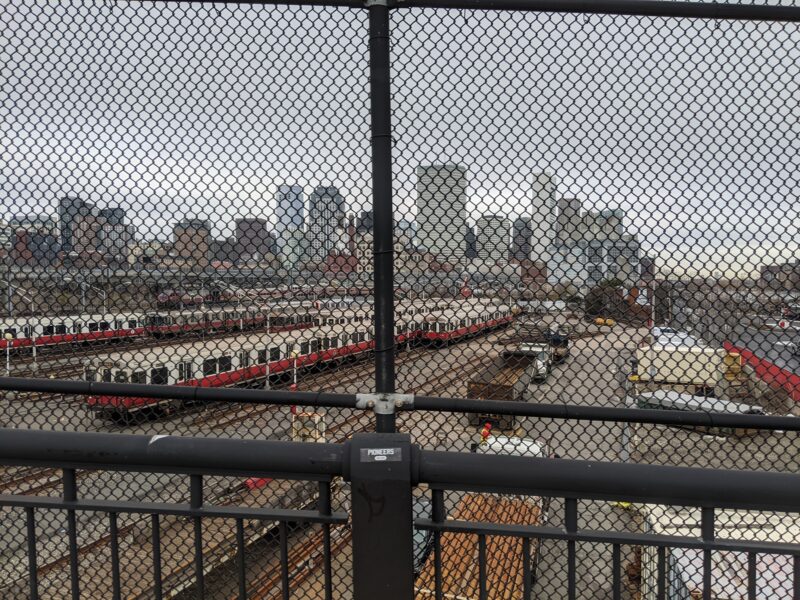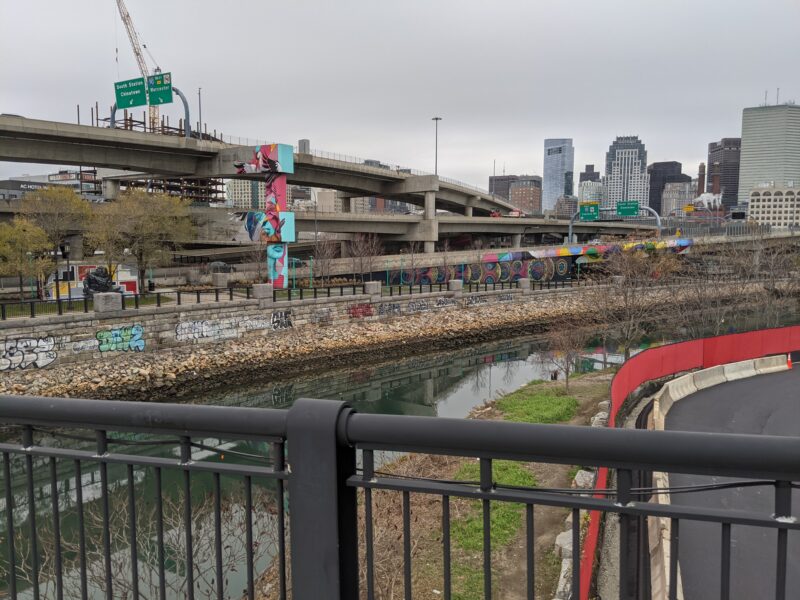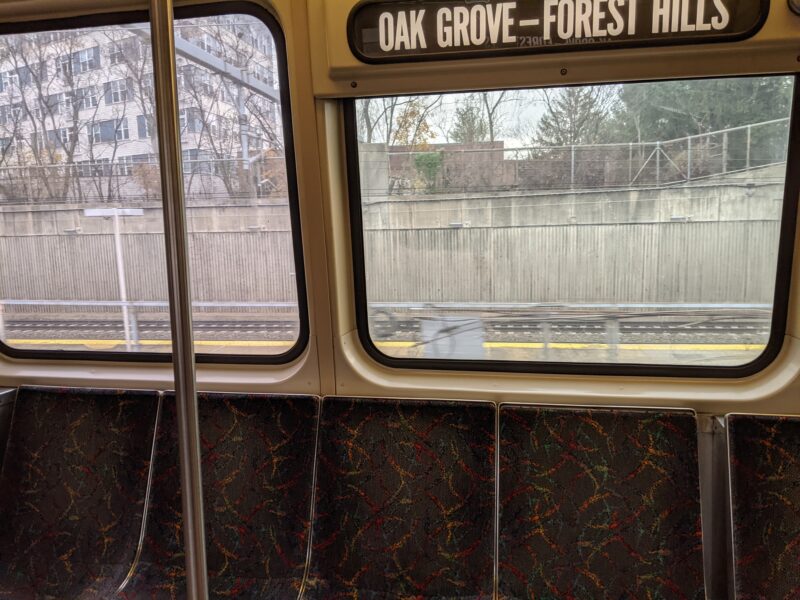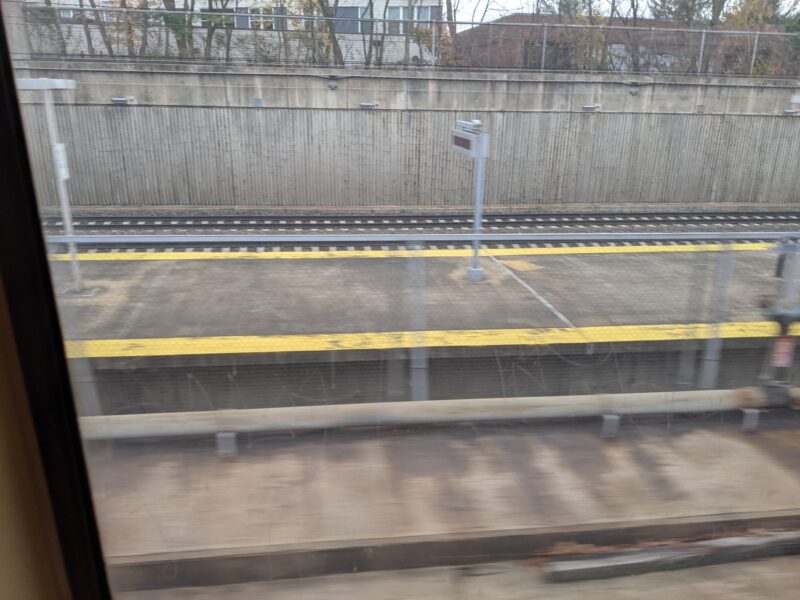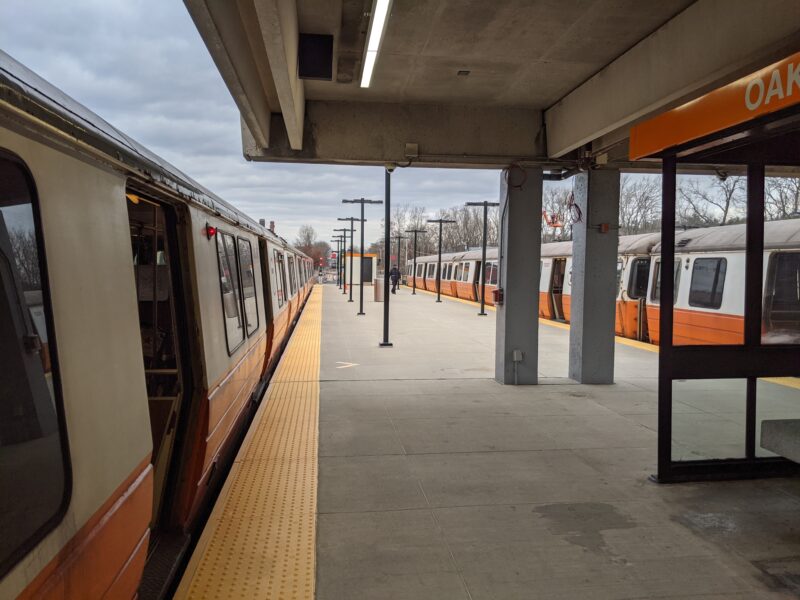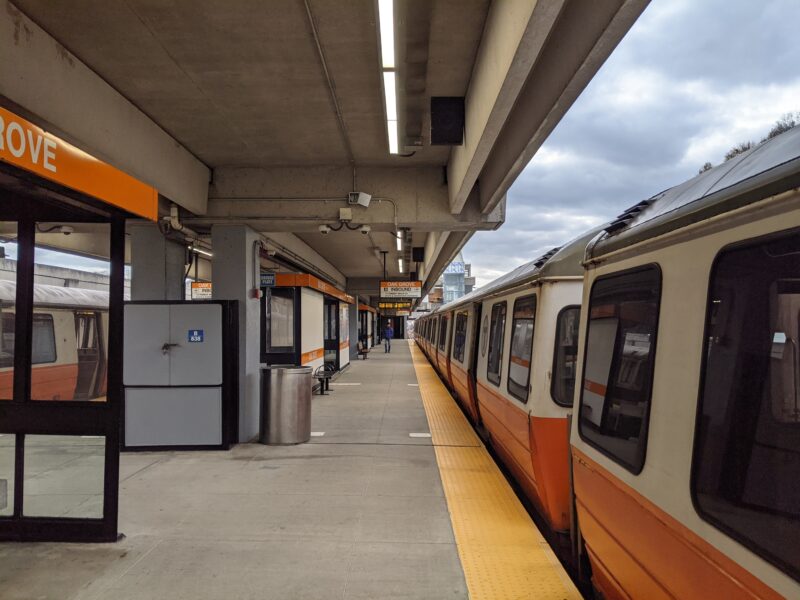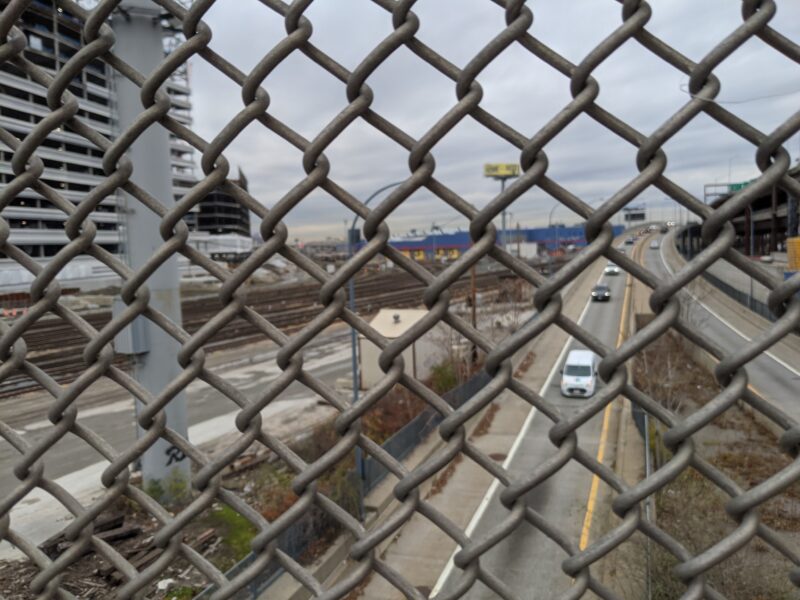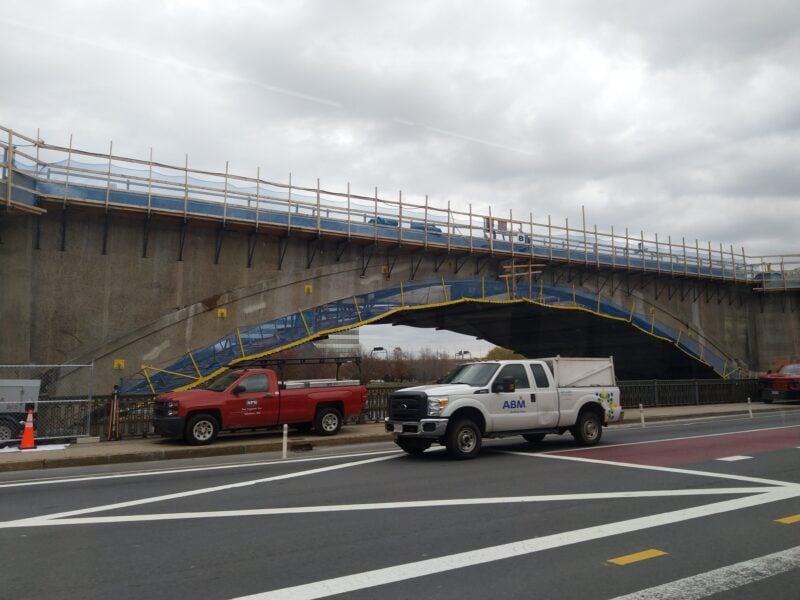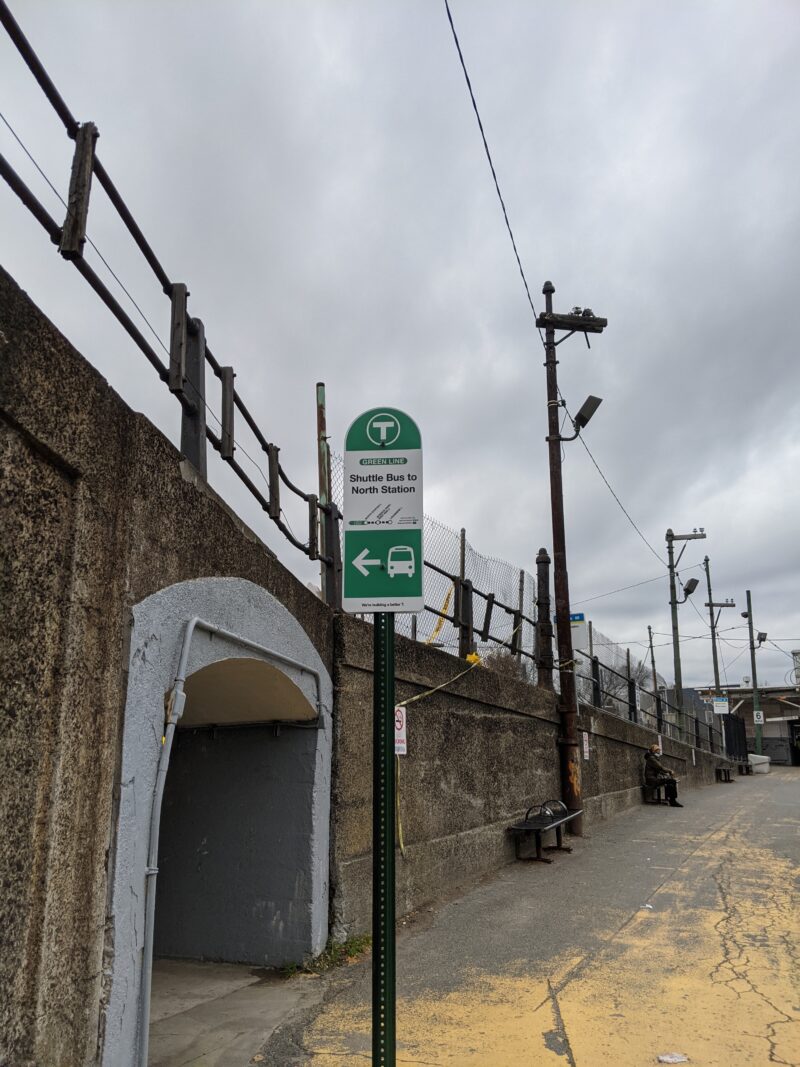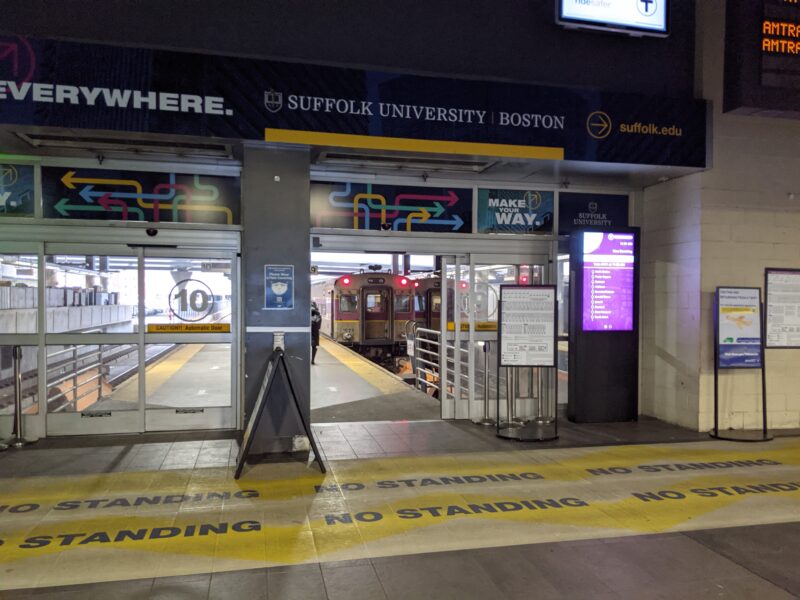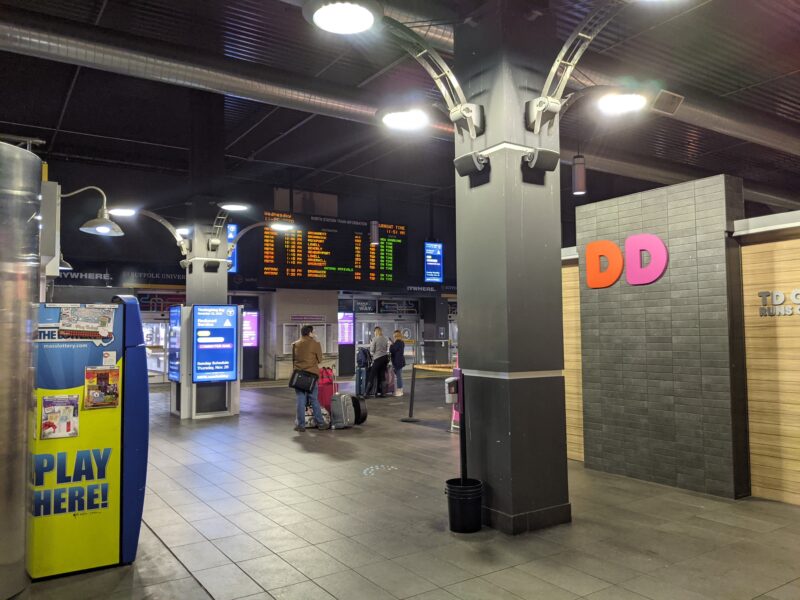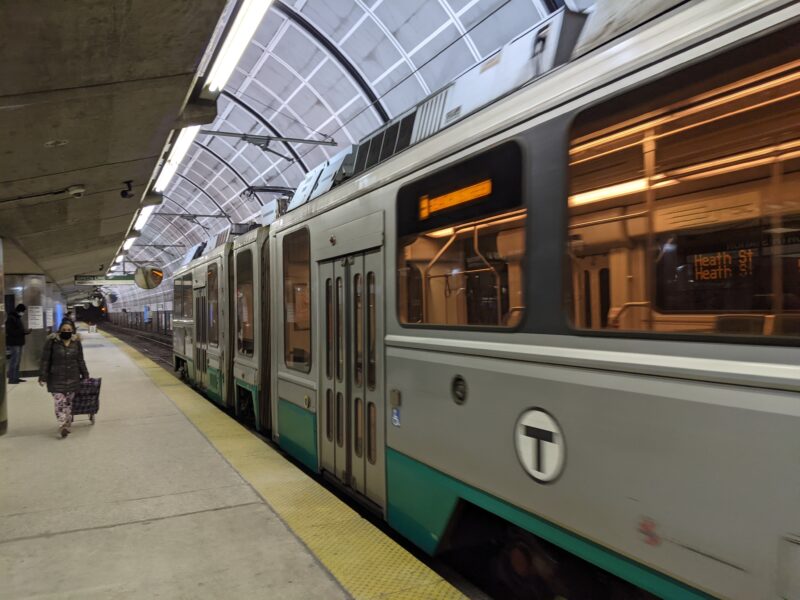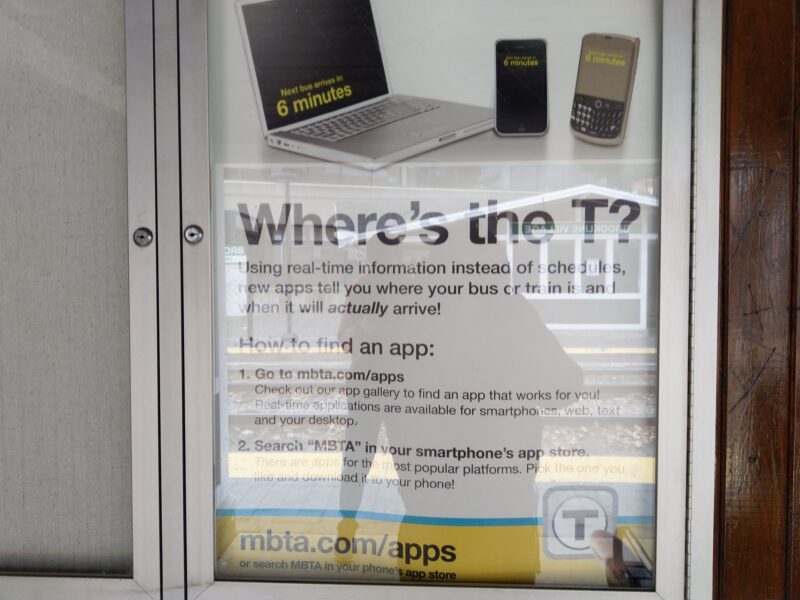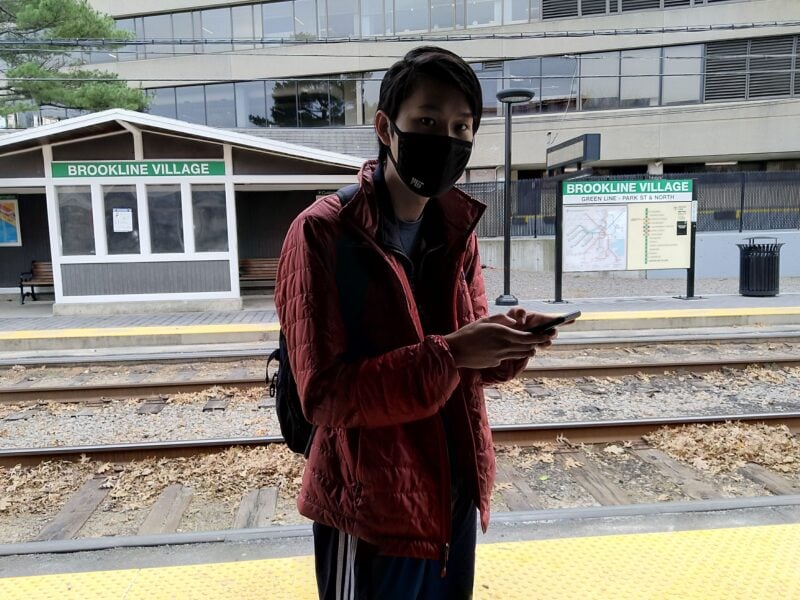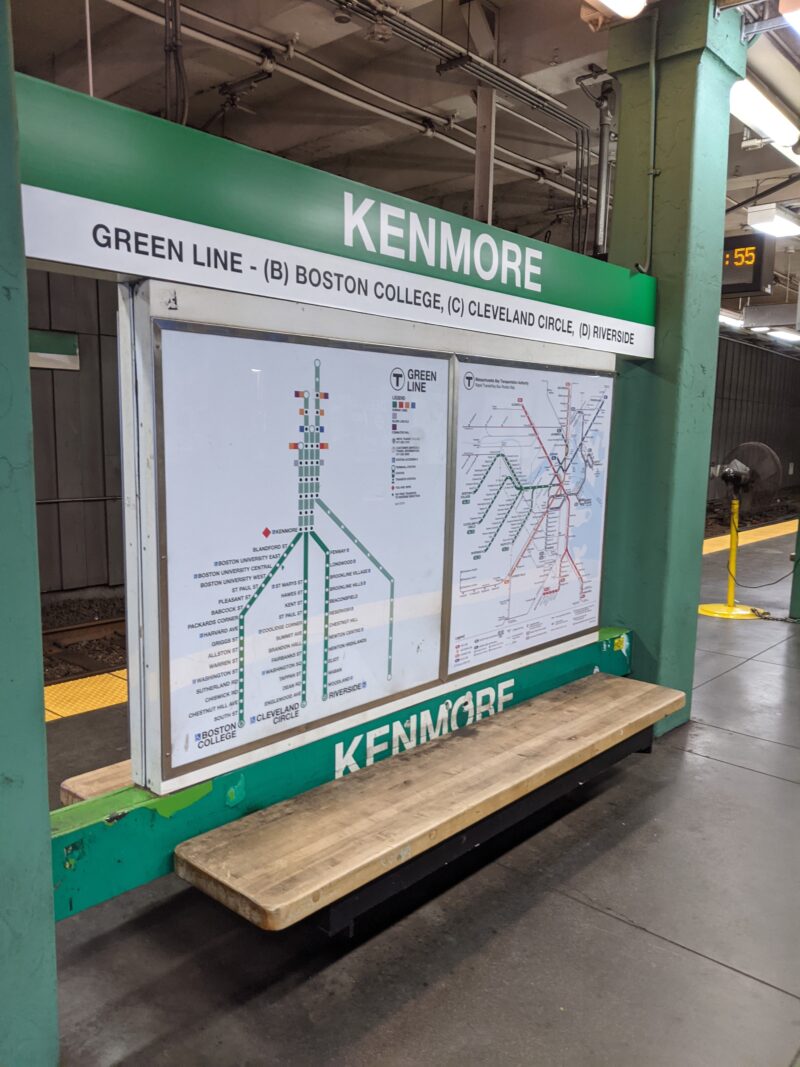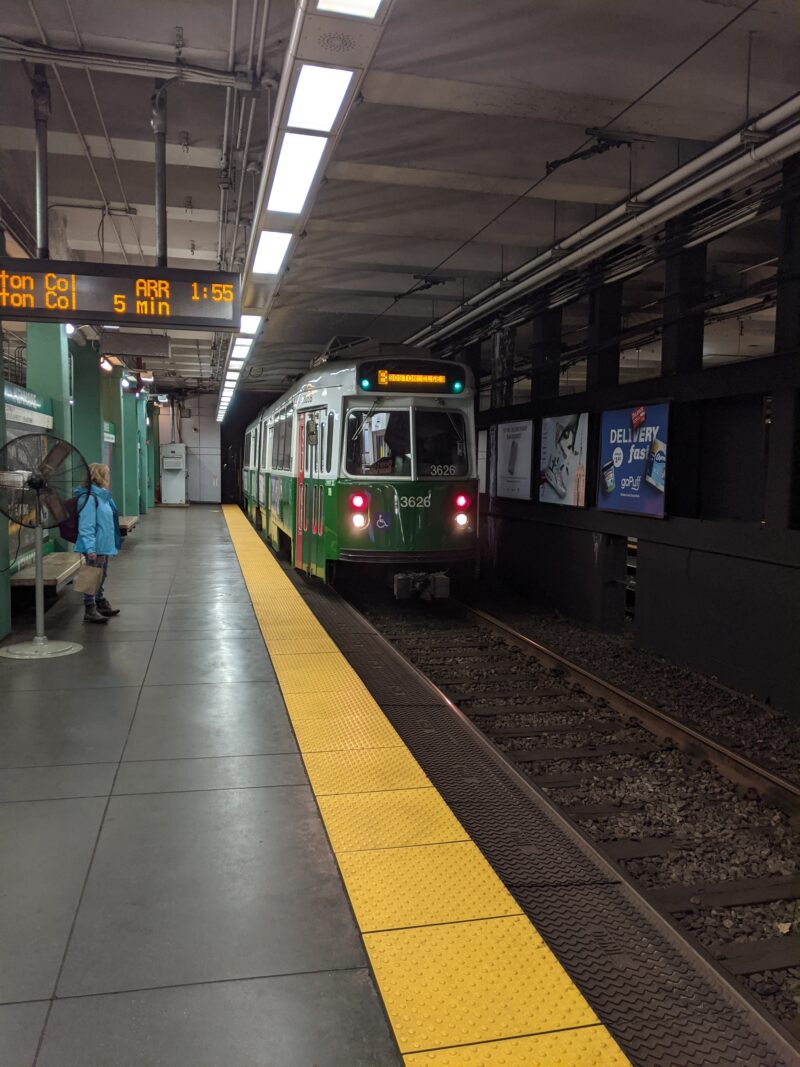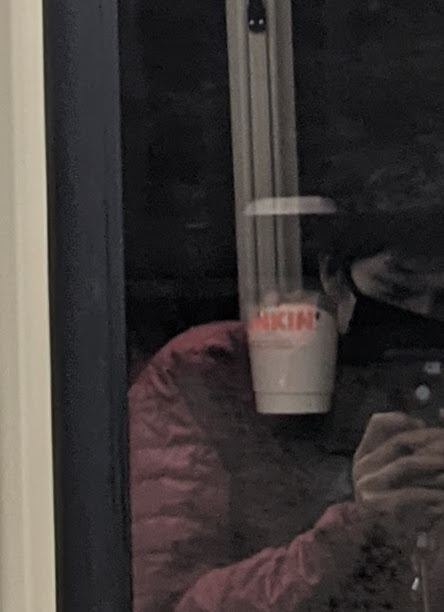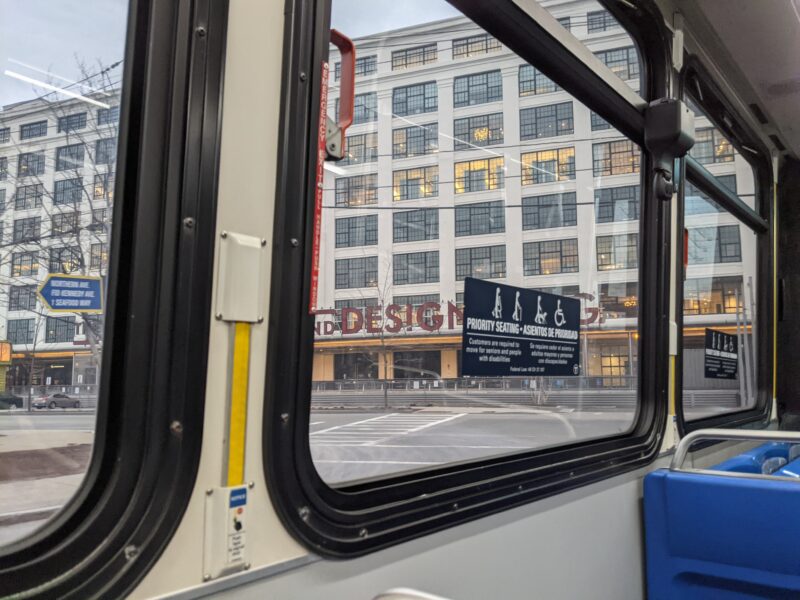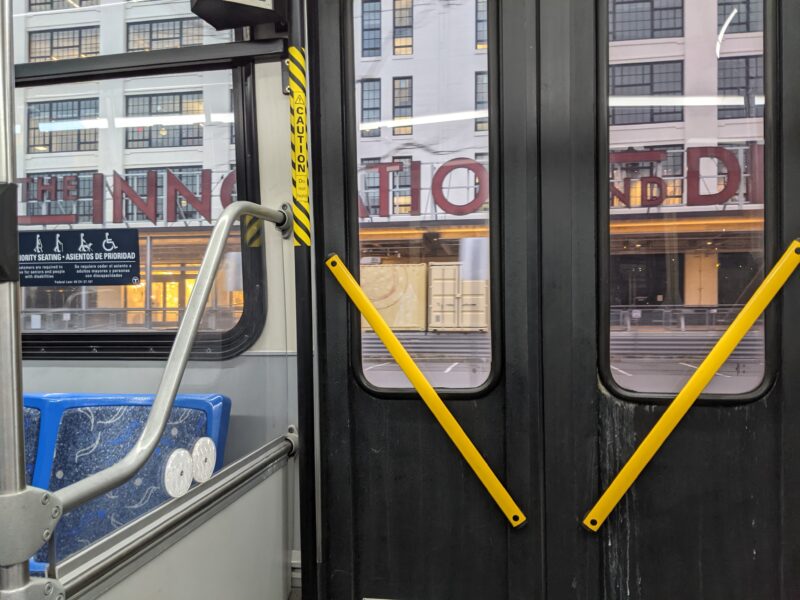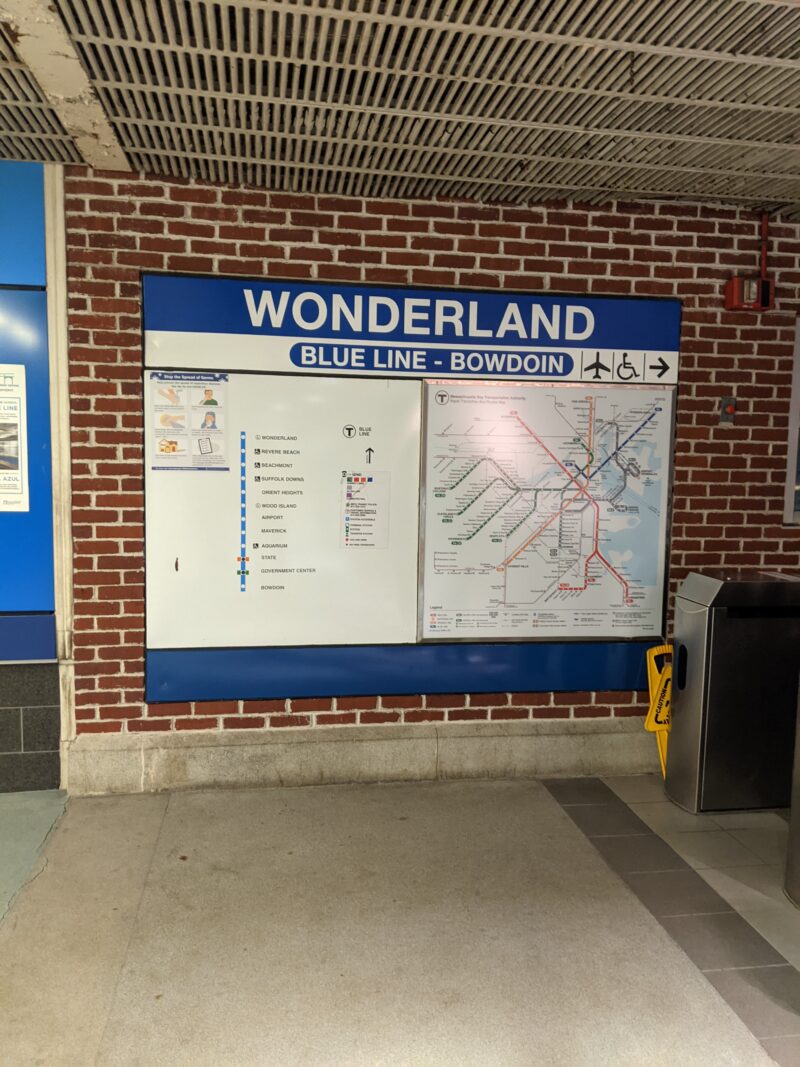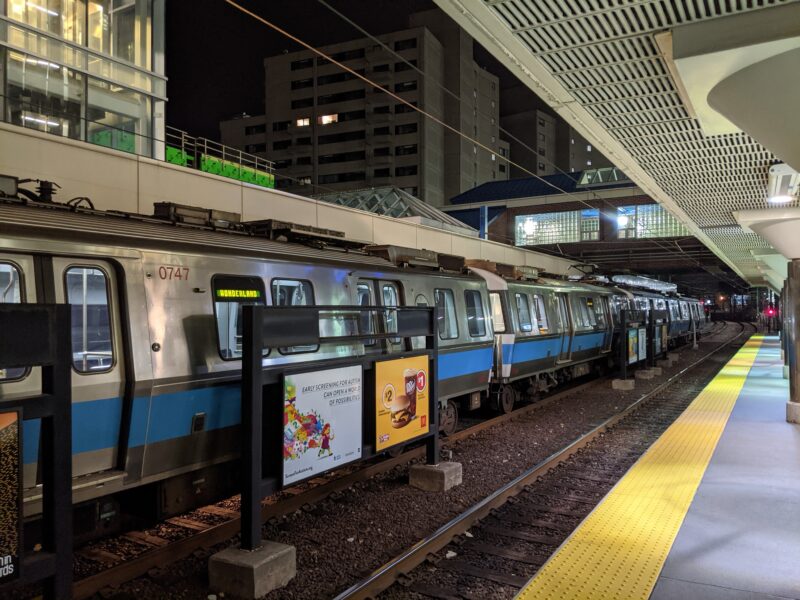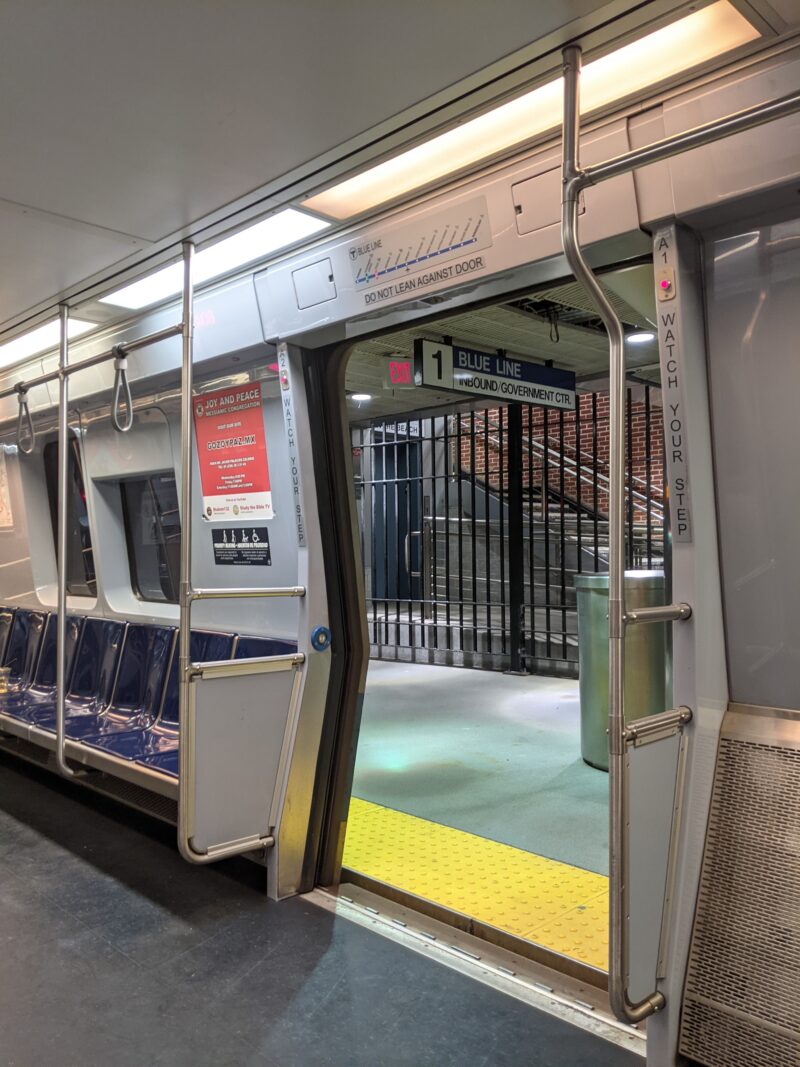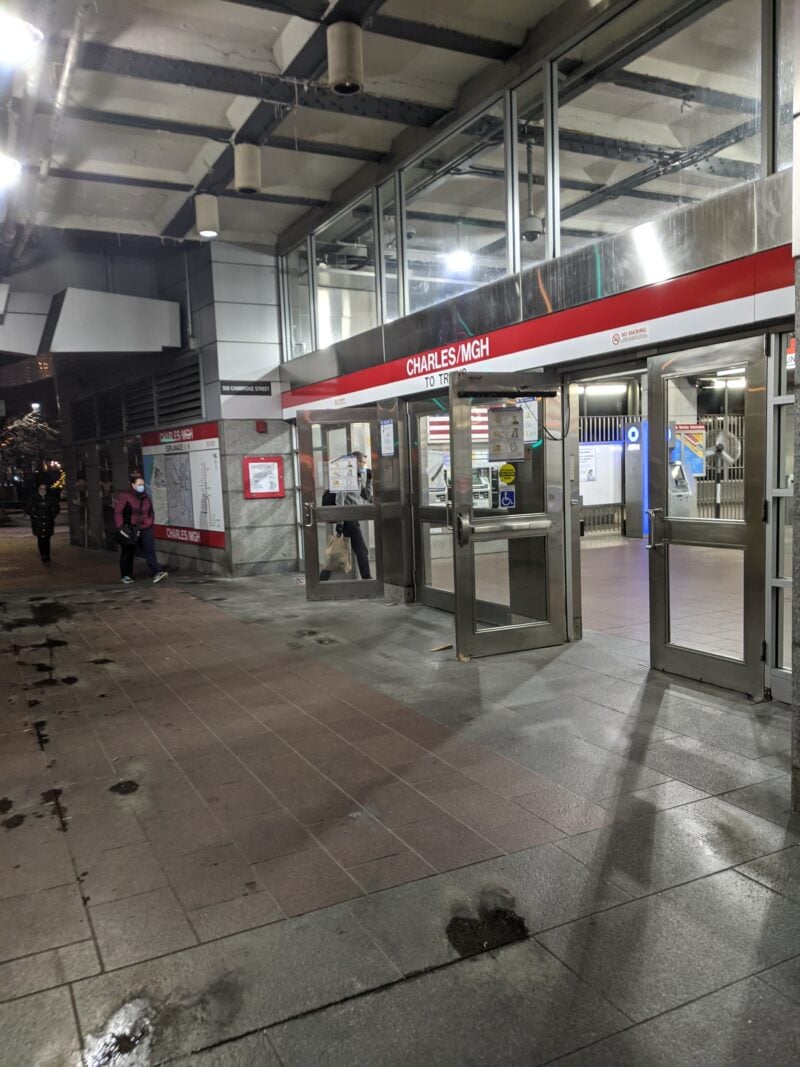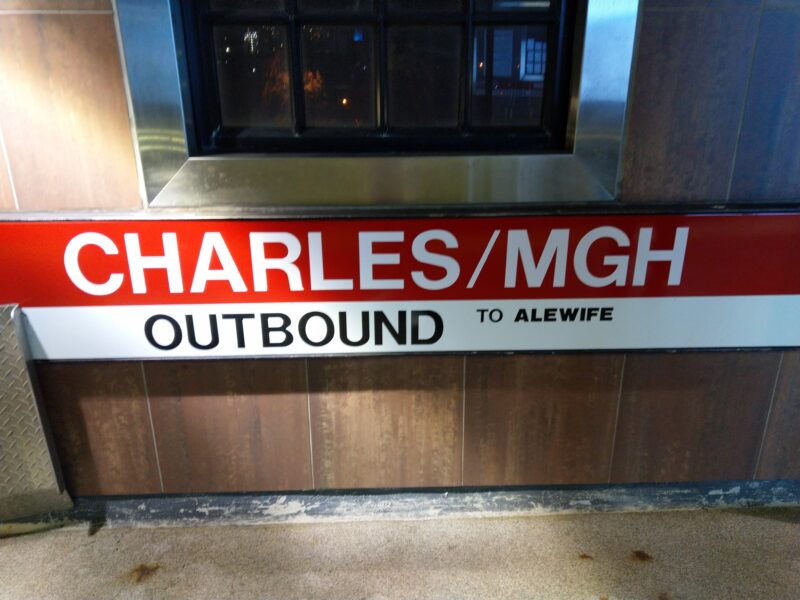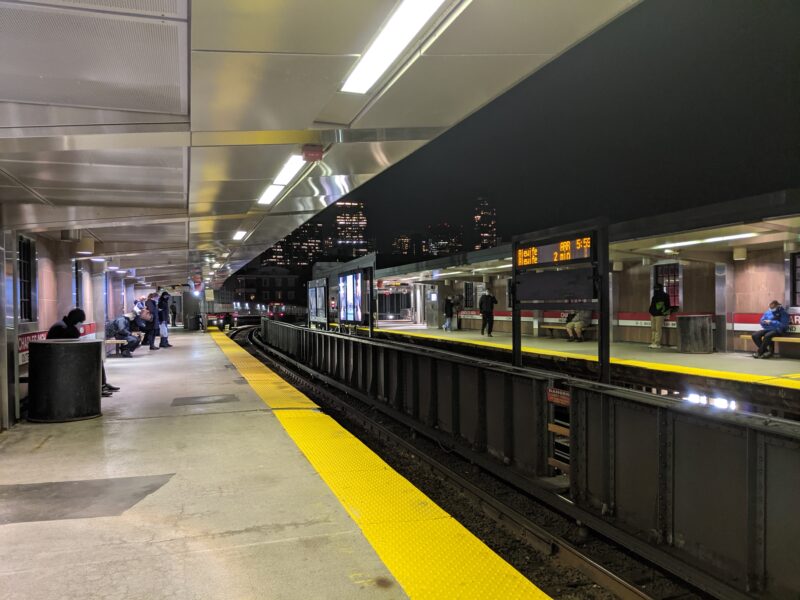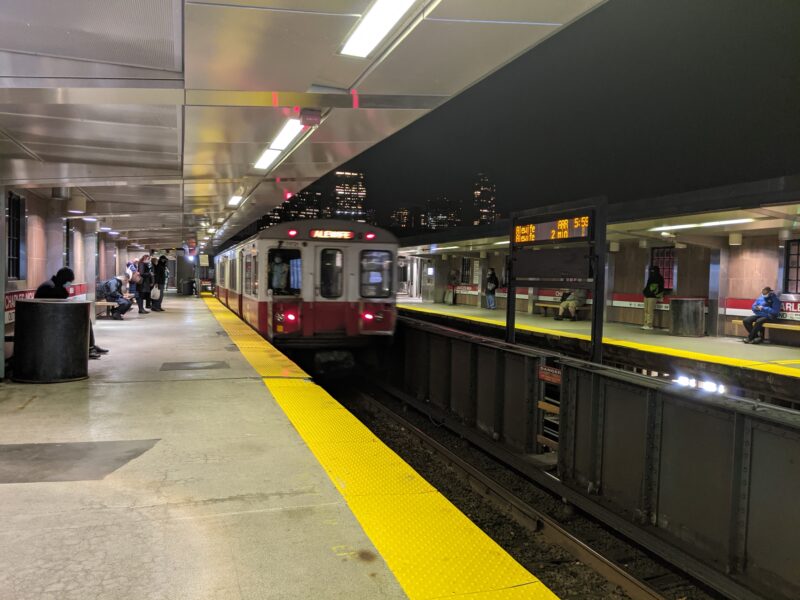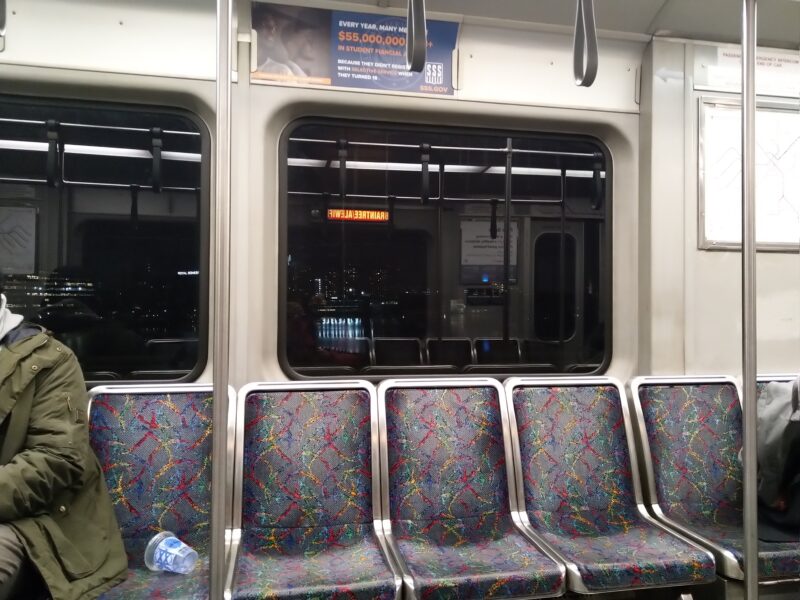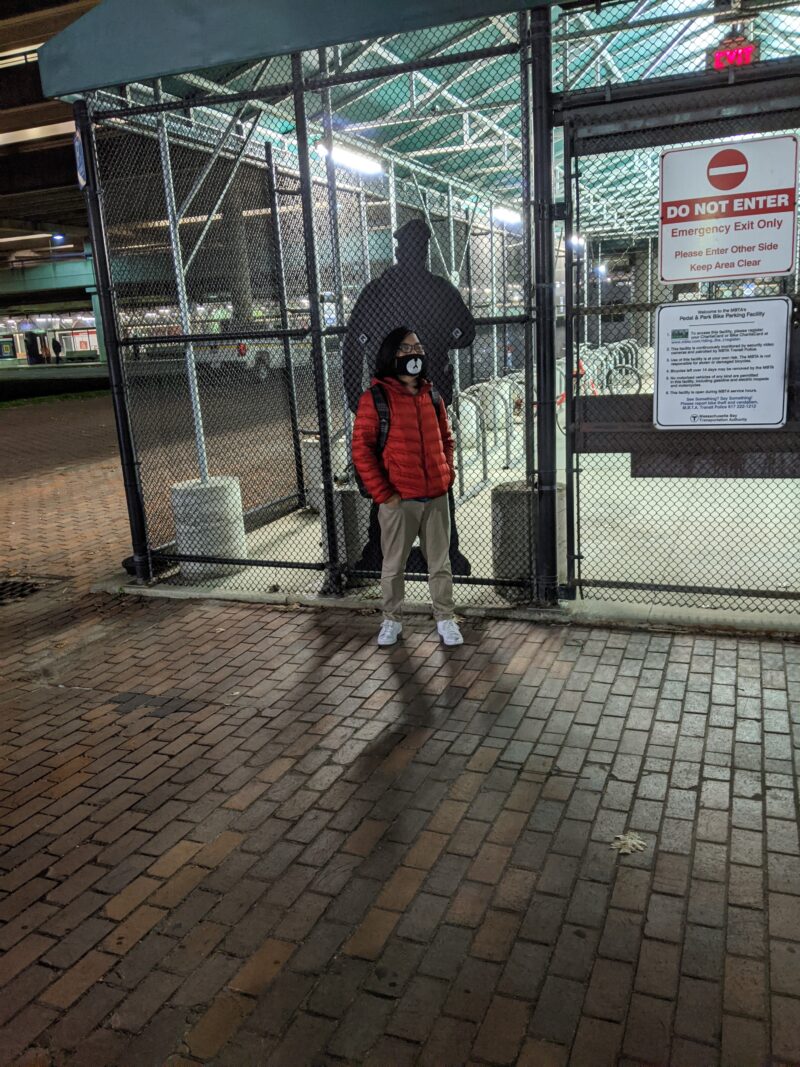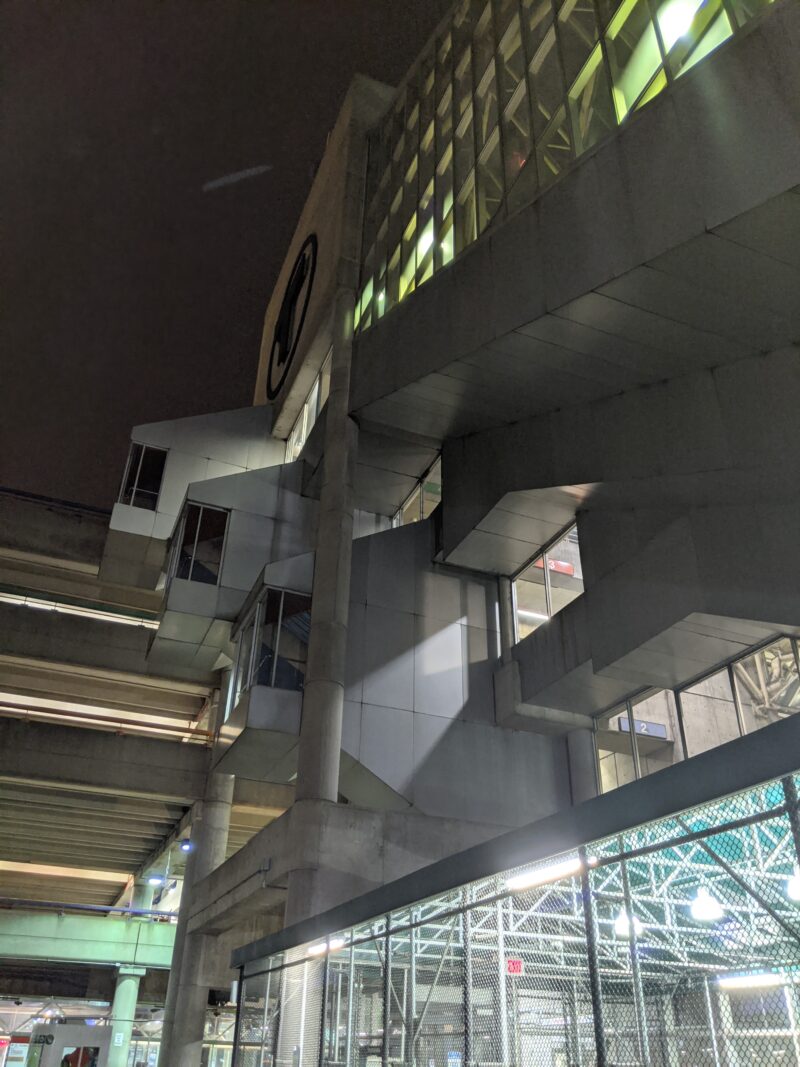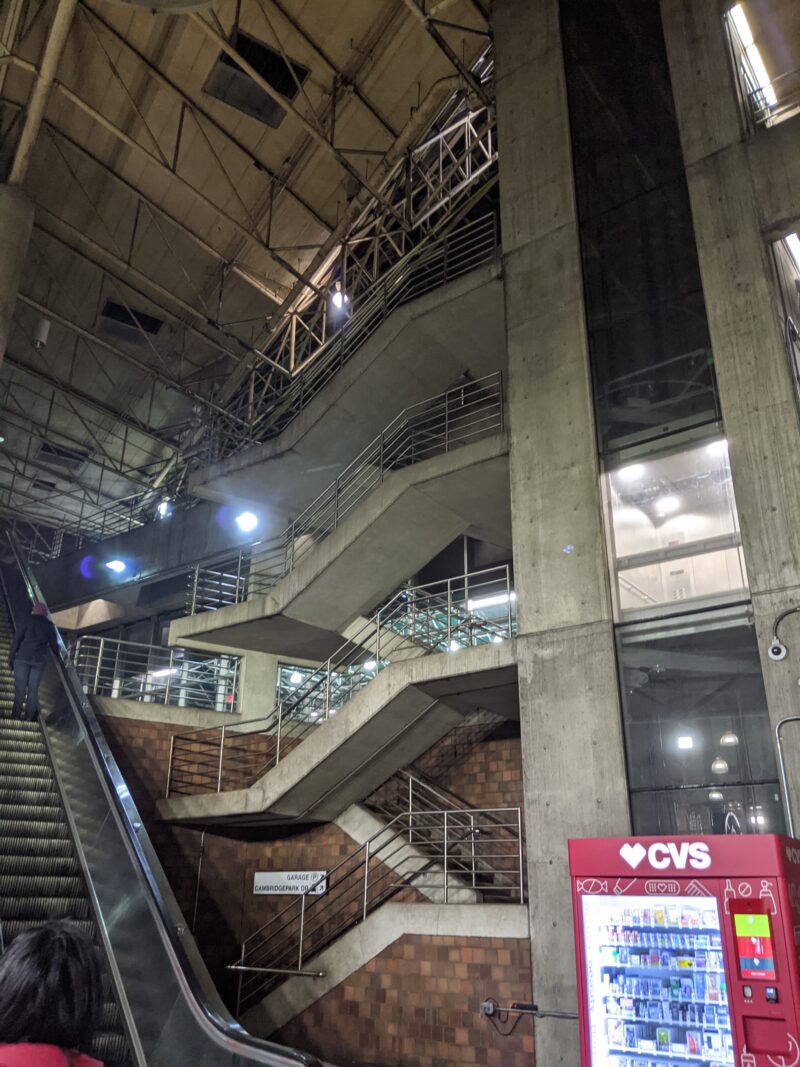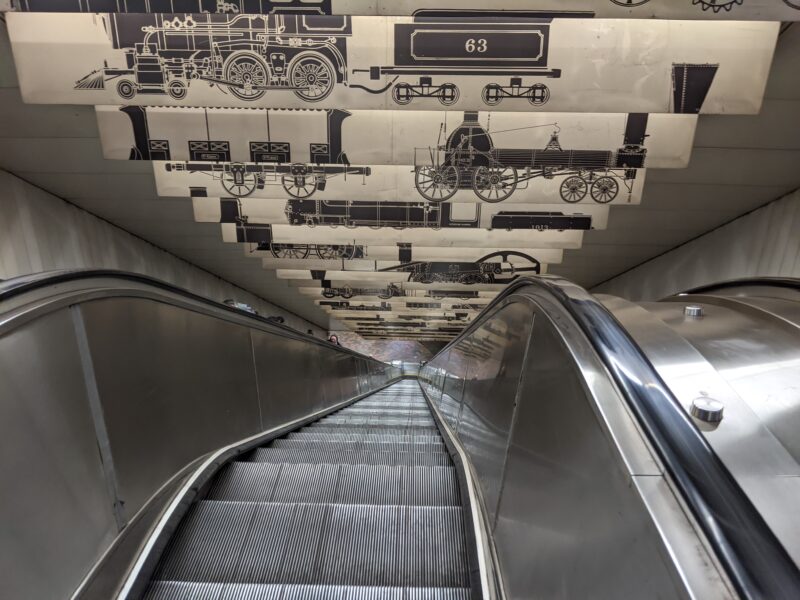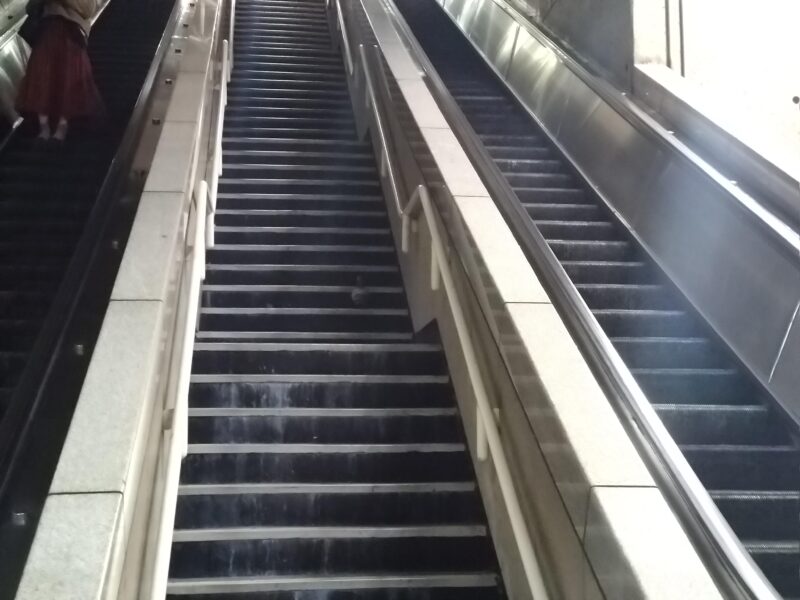
[joint post] we visited every station on the MBTA by Alan Z. '23, MEng '24
and the Logan Airport Rental Car Center
motivation or something
Alan: Like any good scientific paper, we ought to begin this post with a motivation.
CJ: Motivation? There was motivation for what we did?
Alan: …not really. But there is, at the very least, a backstory—
CJ: So some way or another I read about Kevin L. ‘19, who was also a floorpi resident, and how he did a speedrun through all of the MBTA stations, including the Silver Line. He made a post about it on Facebook detailing his route, the times he arrived at each station, and made notes about where he could’ve saved time. It took him 9 hours and 39 minutes. I copied the post and sent it to Alan.
Alan: Unfortunately, CJ underestimated my completionist tendencies. I’d seen a version of this done for the London Underground, so I latched onto the idea pretty quickly. I suggested doing this to CJ…

Alan: for some reason CJ uses discord light mode, also I’m ‘雨新’
CJ: And I said yes. And then a few days later we went to a touchdown space on campus to plan it together.
Alan: Kevin’s path was pretty complete, and we saw limited reason to change it. The one thing it was missing, however, was the Silver Line’s SL3 route, which, for historical reasons,01 there is so, so much MBTA lore opened in April of 2018, after SL1, SL2, SL4, and SL5 were in service.
CJ: We filled a couple blackboards following Kevin’s plan, adding SL3, and talking about the different parts. There were parts when we immediately turn around on a station, or stay on a bus route through a whole loop, and even run between adjacent stations. In some parts of the path, there were even options for us to take depending on which train came first.
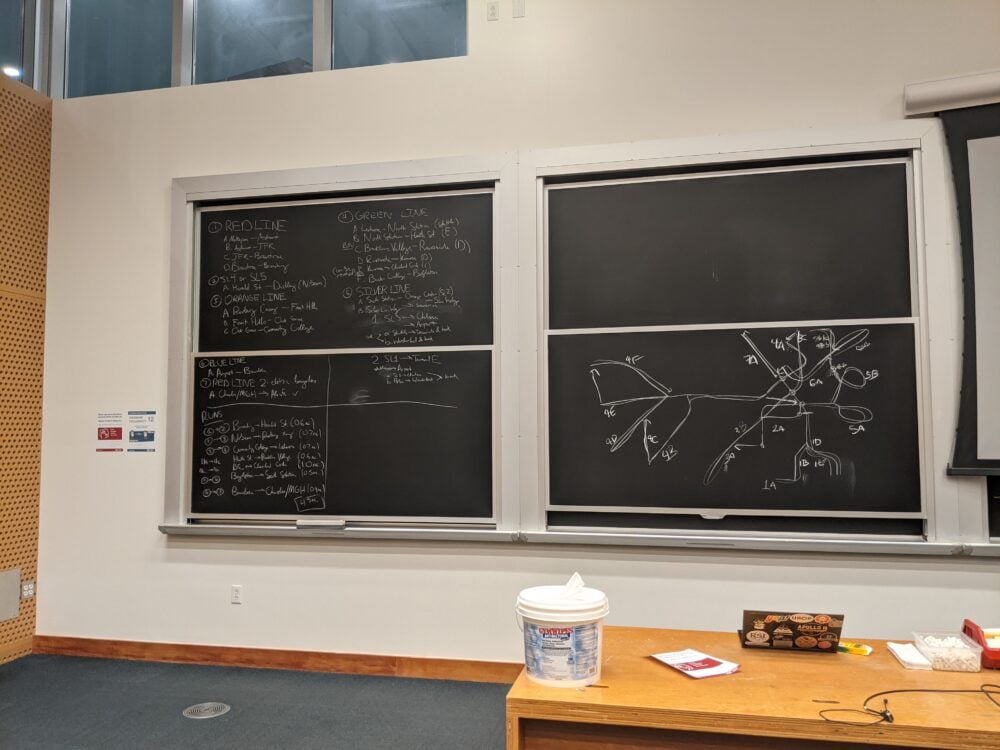
the exact text of these chalkboards isn’t important right now
CJ: There were some sillier things we drew too, like how we complained that there were several nodes with odd degree in the graph of train stations, which meant that there wasn’t an Eulerian path going through all of them. Foiled by graph theory! Alan suggested that we should just build another line to solve this problem.
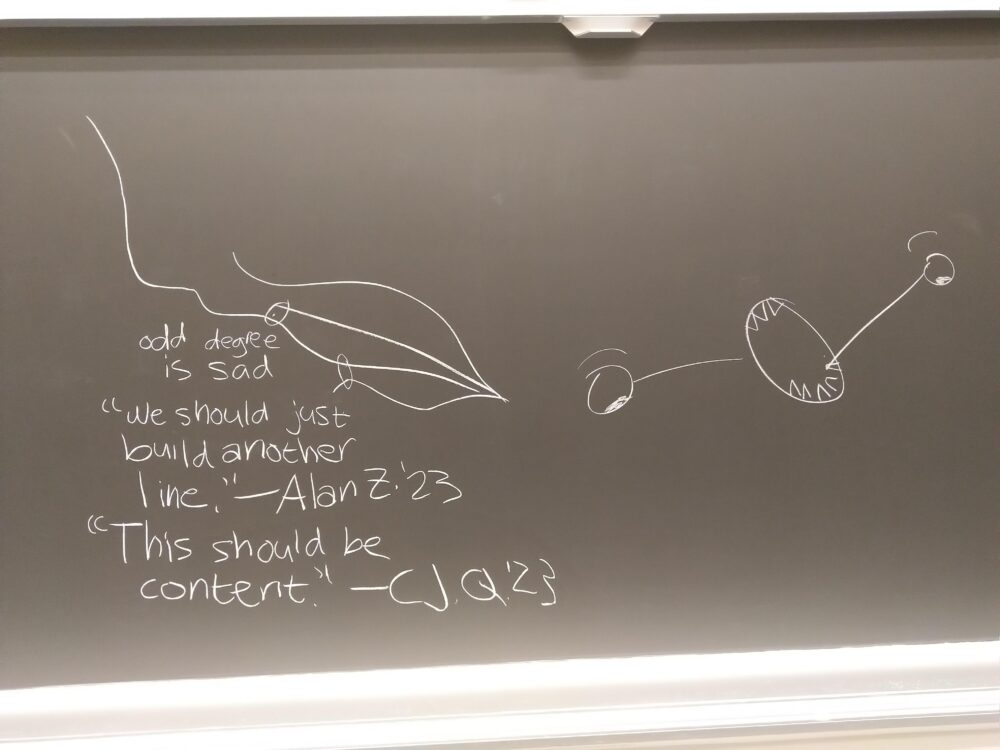
Alan: I’m…going to pretend I know what CJ is talking about. All I know is that the Green Line D branch is too long.
CJ: It is way too long.
Alan: But you will hear more02 <b>much</b> more about that…later. For now, a general overview of the plan will suffice: our journey would start in Mattapan, finish the bottom half of the Red Line first, do Silver Line 4/5, do the Orange Line and all four branches of the Green Line, and then, in some order, finish Silver Line 1, 2, and 3 and the Blue Line, and then end with the top half of the Red Line. A map might be useful to follow along.
CJ: We sent Kevin our plan, and he had some advice for us. Start earlier in the morning than he did, because he started at Mattapan at 1022.03 CJ: I’m gonna write things in 24-hour time for this post. Alan is using less sensible notation. (Alan: For what it’s worth, my timestamps are also in 24-hour time, I’m just writing this way in opposition to CJ’s notation.) Bring food. We asked about restrooms, and he said he had lunch and went to the restroom at South Station, which was roughly in the middle of our trip, so that would work. He also said it would’ve been a better idea to do it at a warmer time of the year, but well…
Alan: The weather was fine.
CJ: Look, when we planned this, the forecast for that day was rain showers, and I didn’t want to run in the rain! We lucked out and it didn’t rain at all that day until an hour after we finished.
Alan: Regardless, we did planning throughout the rest of the week in small chunks. I wrote up a small, convenient website for easy access to walking/overall directions, bought some snacks, and we agreed on a meeting time—6:30 AM, Wednesday, November 25th.
CJ: The website was overkill, really, because Alan ended up memorizing the walking directions.
Alan: This is false. I was secretly pulling up the walking directions from the website every time we made a transfer.
CJ: Okay, sure, but you also made a spreadsheet.
Alan: …yes, and?
CJ: That was definitely overkill. Or, I don’t know. We can talk about the spreadsheet later. Anyway.
Alan: Anyways.
getting started: red line, part one
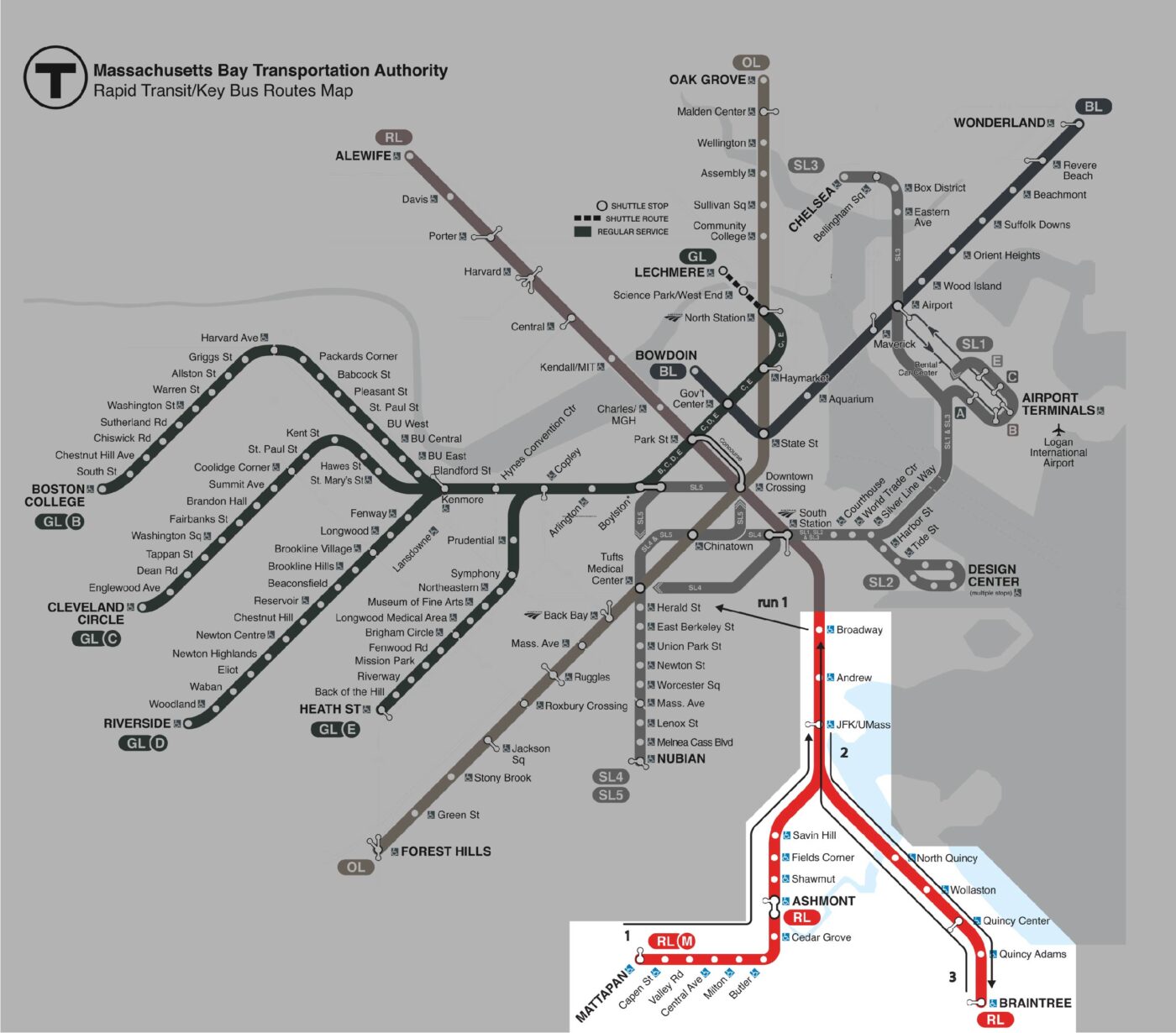
apologies for ugly graphic design
CJ: Wednesday was the day after Tuesday, which was the day that people who were staying on campus moved to Simmons or Next. I talked about moving in another post, but what I didn’t mention was that when I dropped off my boxes in the East Campus lobby on Tuesday morning, they didn’t actually arrive in Simmons until the next day. So the night before our trip, I slept on a bare mattress. It was an awful experience, zero out of ten do not recommend.
Alan: I, fortunately, did not have to move at all. Something something already living in Next House privilege.
CJ: I woke up, ate a banana, and met up with Alan outside Simmons. It was like, zero degrees out. I didn’t have my good jacket with me, because it was in a box, so I was cold, and I was hoping that it’d warm up later in the day.
Alan: Fortunately, it was zero degrees Celsius, and not zero degrees Fahrenheit—otherwise we would’ve had a real problem. In any case, we walked up Vassar Street towards Kendall Square in the cold for a bit, and then took an inside route through the main group buildings and the tunnels, eventually arriving at the T station after maybe 20 minutes or so.
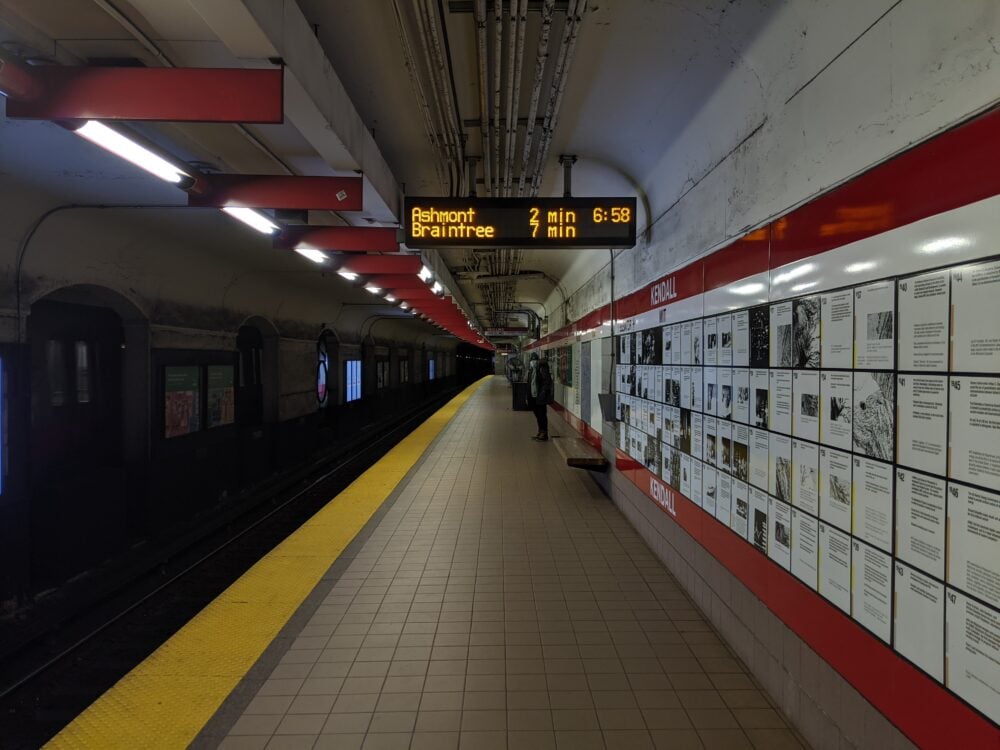
CJ: It’s 0657 and we’re at Kendall Square. We buy one-day passes, they cost like $12.
Alan: The ticket machine eats my first one-day pass, jams, and then converts to taking CharlieCards only. There is no MBTA Service Representative at the station. I buy another one-day pass.
CJ: Press F for Alan’s jammed ticket. F. I was lucky and was spared the wrath of the ticket machine. Our first stop would be Ashmont, then taking the trolley to Mattapan, where we’d officially start our timer.
Alan: sigh. At the very least, the train came pretty quickly, and then we were on our way!
CJ: Along the journey we talked about the path we were taking and whether we could’ve made Kevin’s path better. This is the travelling salesman problem, and we talked about approximation algorithms for TSP. It turns out that since we could visit stations twice, this reduces the problem to metric TSP, and hence had a 1.5-approximation04 I learned some of this in 6.854, an advanced algorithms class I’m taking that I <a href="https://mitadmissions.org/blogs/entry/ridiculous-things/">previously talked about</a>. (Alan: <a href="https://www.quantamagazine.org/computer-scientists-break-traveling-salesperson-record-20201008/">very, very slightly less than 1.5</a>, based on <a href="https://arxiv.org/abs/2007.01409">recent work</a>.) that we could’ve calculated if we wanted to. But I’m into theoretical computer science, and applying algorithms to real-life problems is hard. Anyway.
Alan: We got down to Ashmont and then transferred onto the Mattapan High-Speed Trolley, which gets credit for going to Mattapan and being a trolley, but definitely does not get credit for being high-speed.
CJ: To be fair, it was faster than the Green Line.
Alan: Spoilers for the rest of this post. At Mattapan, we got off of the trolley we were on, crossed the tracks, and then got onto a trolley headed back to Ashmont. I started the stopwatch on my phone as we started moving.
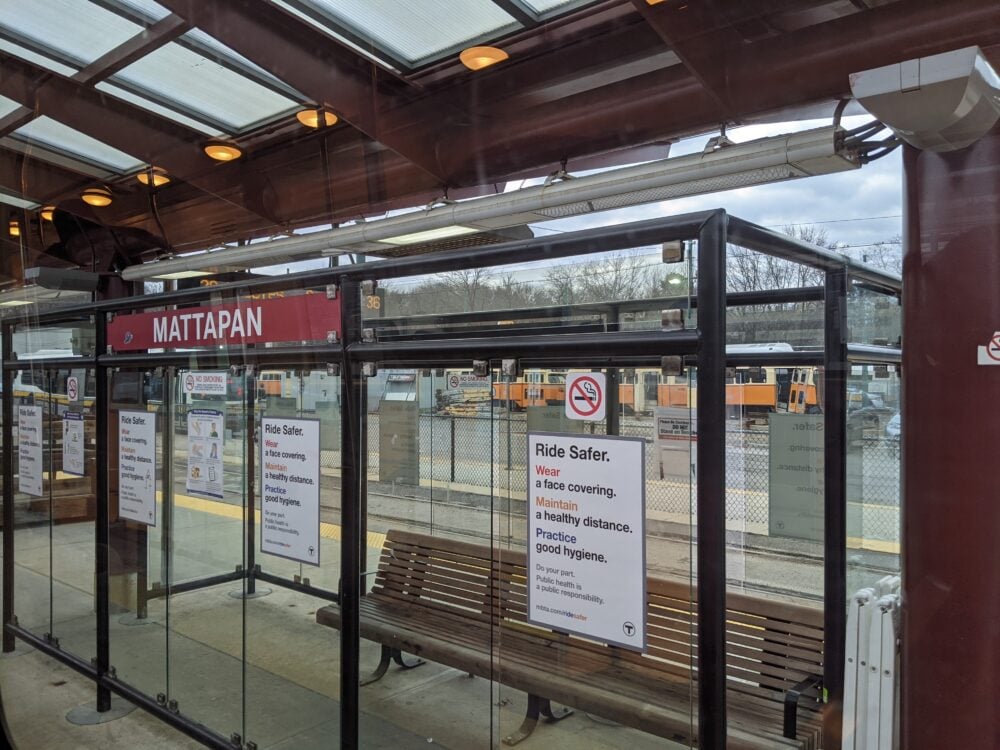
CJ: Mattapan, 0735. Along the way, we passed by a cemetery that I took pictures of, because I think cemeteries are cool. It’s a blurry picture, but bear with me, please, it was a high-speed trolley.
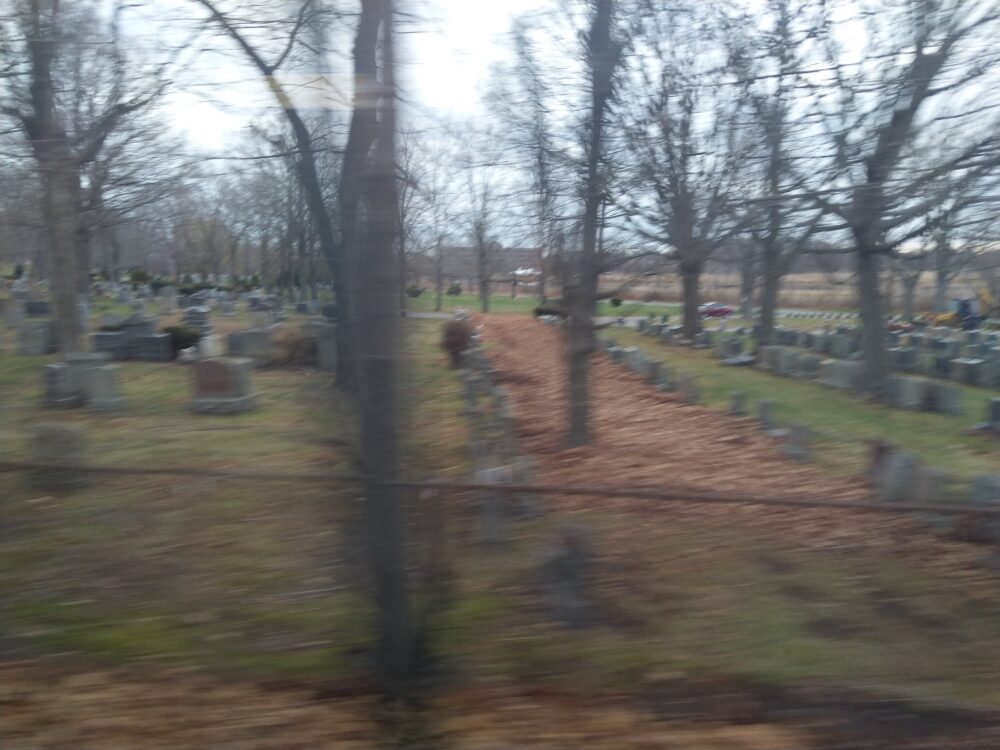
Alan: Along the track near the cemetery, there’s also a “Your Speed” sign, like the kind you see on the road which tells you when you’re speeding. That sign read “15” and was also flashing.
CJ: See, 15 is high speed!
Alan: Maybe 15 meters per second, but even that’s slower than a car on a normal road.
CJ: Cut it some slack. Anyway, we arrive at Ashmont station by 0744, nine minutes later. Then we transfer to a train headed inbound. We sit on the train for about four minutes before it departs.
Alan: We felt like we had lost time because of this slow transfer. How deeply, deeply naïve of us. Our second transfer occurs at JFK/UMass, which we arrive at around 7:59 AM. We intend to switch to the Braintree branch of the Red Line here; the terminus at Braintree is the southernmost station in the MBTA system.
CJ: Wow, ï with the diæresis.
Alan: Wow, æ with the ‘a’ and ‘e’ joined together.
CJ: So we made it to JFK/UMass. We crossed the platform to board the Braintree train. And then the board thing said that the next train to Braintree was six minutes away. Two minutes later, it was still six minutes away.
Alan: And then, it switched to a message that still haunts me to this day—
CJ: Stopped 2 stops away. shivers
Alan: The time for the train behind it is still decreasing, so we think for a brief moment that perhaps it will come and save us. That hope, too, is crushed by its eventual stoppage… 3 stops away.
CJ: The message on the board then switched. A voice read the announcement, and it didn’t sound like a prerecorded one.
Alan: We are experiencing delays of up to 15 minutes southbound on the Braintree branch due to a disabled train at Broadway. Or…something very similar to that.
CJ: Must’ve taken them like ten minutes to find the guy who says the announcements and ask him to record the message. Alan remarked that we could write a play about this, and I said maybe we could call it Waiting for the Train. Like Waiting for Godot. And in the play, Godot never actually arrives.
Alan: We wait on the Braintree platform for a good while. In the meantime, I get some pictures of the trains that are still passing through JFK/UMass—the inbound train to Alewife and the commuter rail.
Alan: Eventually, a train going to Braintree which is not accepting passengers passes by. Then, a train originally destined to Ashmont rolls by—it, too, is not accepting passengers. It passes by the Braintree platform, and then onto the hill just outside of the station…and it stops there. We wait as it slowly inches its way out of view, and the next train to Braintree finally enters the station.
CJ: Two disabled trains and 28 minutes later, we finally got on a train headed to Braintree!
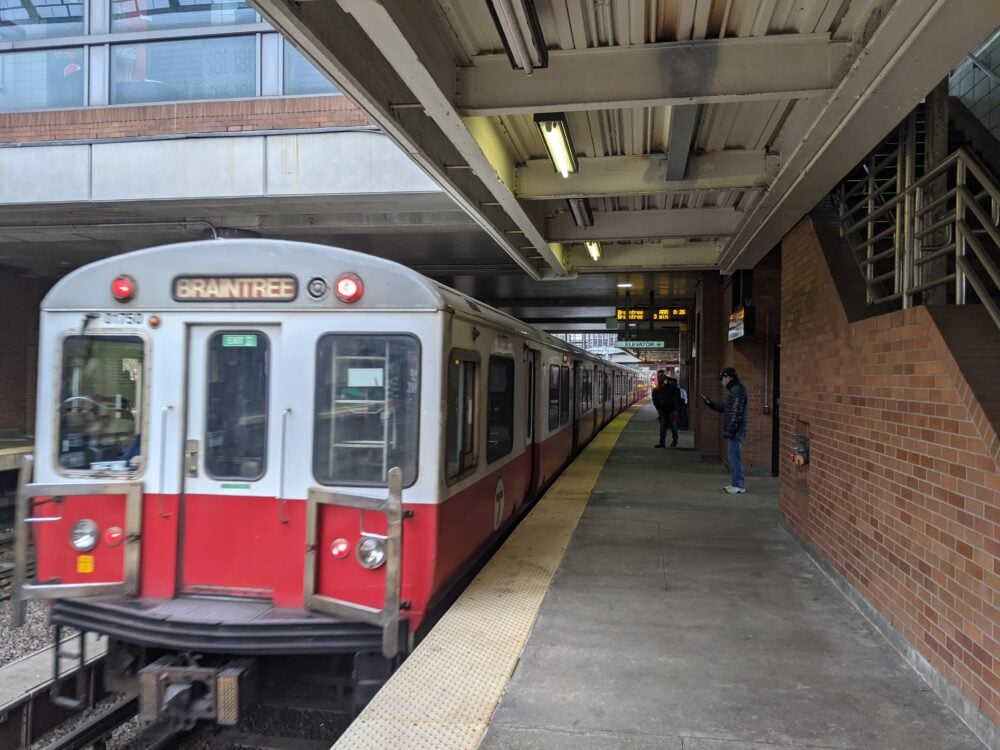
finally, our train
Alan: On our way down, we are still behind the disabled train. We get stopped outside Wollaston, slowed down outside Quincy Center and Braintree, and overall it is just a remarkably slow journey down this branch of the Red Line that is pretty long. CJ falls asleep.
CJ: I remember Alan saying that the estimated time we finish the Braintree branch and head back up to Broadway should’ve been 0907 or something.
Alan: Instead, we ended up at Braintree at 9:03 AM. I have never been so happy to see any MBTA station, not to mention Braintree.
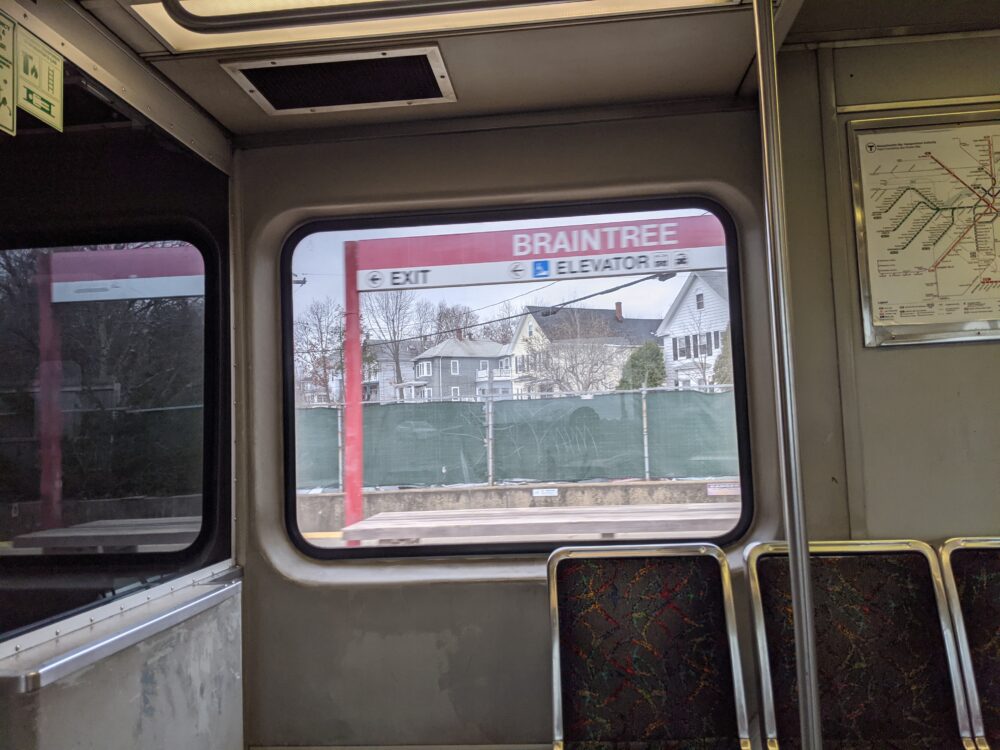
apologies for the blur
CJ: At Braintree, we get out of the train, realize that the same train was going to go back up, and get back in again. One minute later it starts going inbound. I tell Alan that we’ve used up all of our bad luck at this point and the rest of the journey would be totally fine.
Alan: Hahahahahahahahahahahahaha.
CJ: Probably the only good thing about the whole delay situation was this street performer at Quincy Center. He had a bear mask on and was playing on… a keyboard? A key-tar? Is that what they’re called?
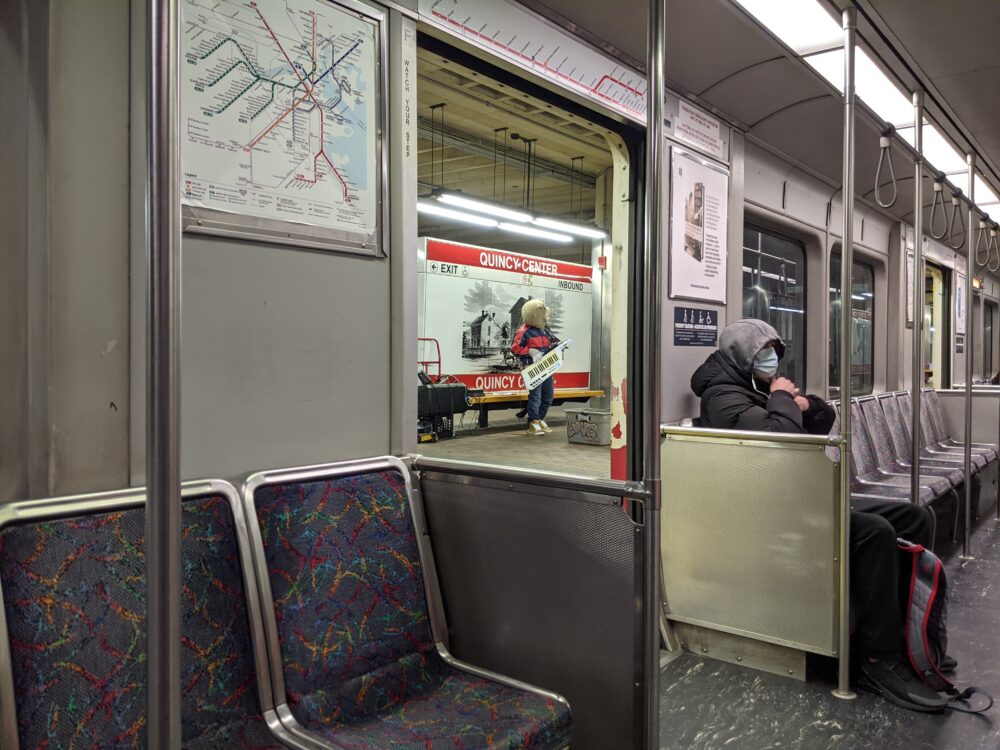
Alan: This…this character has a Wikipedia page: https://en.wikipedia.org/wiki/Keytar_Bear.
CJ: Wait what, seriously? Gosh. We saw a celebrity and didn’t know it. The page writes that Mick Jagger said he’s a fan of the bear! Woah. Hey, do you think the delays were worth it just to see Keytar Bear?
Alan: Absolutely not.
CJ: We make it back to JFK/UMass, and then take the same train two stations up, passing by Andrew, and getting off at Broadway. It’s 0932.
things go mostly according to plan: sl4 and the orange line

there’s at least one mistake in all of these maps, see if you can find it
Alan: It’s time for physical exercise!05 The FitnessGram™ Pacer Test is a multistage aerobic capacity test that progressively gets more difficult as it continues. 06 CJ: Alan said he was going to add an annotation here and that everyone was going to hate it. After now reading it, I agree, I hate it. He now says he has a keyboard macro for this. Seriously, Alan? (Alan: Yes.) We’re making our first of seven out-of-station transfers—otherwise known as running between stations!
CJ: The total distance we’d run in out-of-station transfers was 4.5 miles in our plan. That night, I remember saying it didn’t seem that bad, since it would be spread out over seven runs. I did not consider the facts that, one, it was freezing cold outside, two, a lot of our paths had a slight slope up, and three, I was really, really out of shape. I was running out of breath two minutes into the run to the next station, and I felt Alan’s glare of death as he took some photos.
Alan: Oops. Anyways, these pictures might look somewhat familiar—because they occur in the same area as a previous adventure of ours. We crossed into South End and headed north, just grazing the southernmost07 this originally read ‘most southern’ until CJ made fun of me for not knowing words part of Chinatown at—
CJ: The Herald Street station! It’s 0943 and we were now waiting for either the SL4 or SL5; both buses took the same route from this point forward. We waited in that shed for four minutes. Alan observed that the map of the T there was very recent, as it had the updated name Nubian, for the station previously known as Dudley Square.
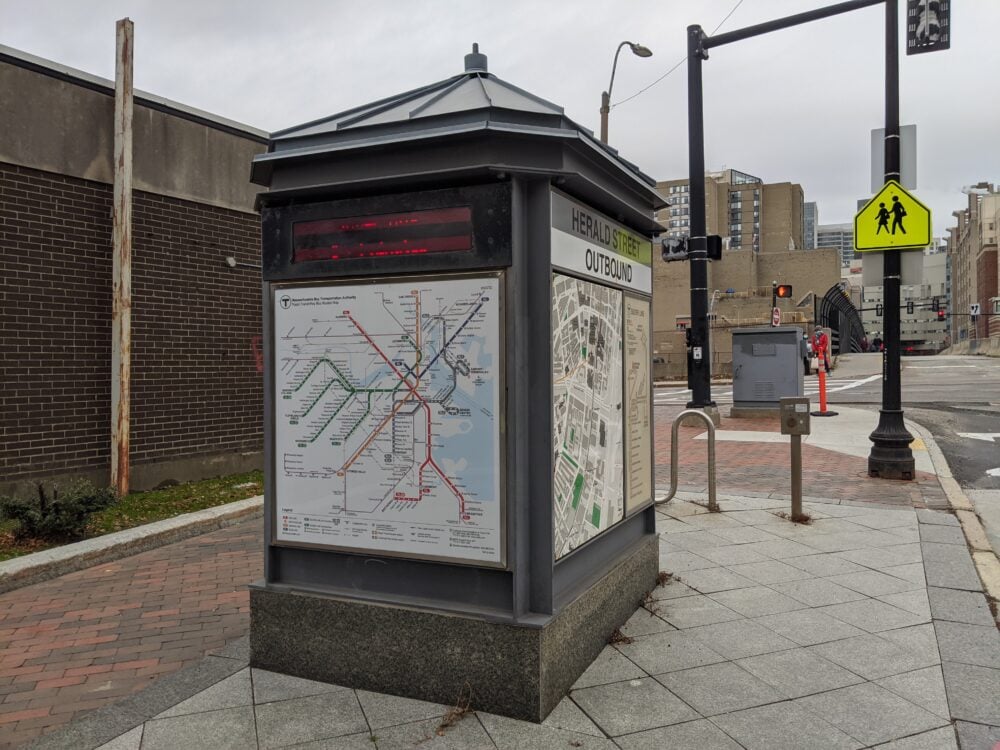
I don’t have a close-up of this map, but I promise it says Nubian
Alan: Also note that SL4 and SL5 are, in fact, just long buses, but they are part of the Silver Line because of—wait for it—MBTA lore (most of which involves budgeting).
CJ: All of this MBTA lore better make it in a future post.
Alan: No promises. The SL5 comes first, but it’s full and there’s an SL4 bus right behind it. It takes us down a short jaunt to Nubian Square, where our next run begins.
CJ: I remember we were sitting in a rear-facing seat for that ride. I hate wayback seats08 Alan: I did not know they were called this. with a passion, because I used to easily get motion sickness from them. For the rest of our journey we would only sit on seats facing the front or the sides. Anyway!
Alan: Next run, from Nubian to Roxbury Crossing, on the Orange Line! Most of our path was on the sidewalk next to a pretty wide boulevard, passing a couple schools along the way. The run turned out to feel somewhat shorter than I expected, which was nice.
CJ: There was a Domino’s at Roxbury Crossing Station and I said I wanted Domino’s. Then Alan said, too bad, it’s still closed. Or something like, too bad, we still have one hundred more stations to go.
Alan: Probably the latter.
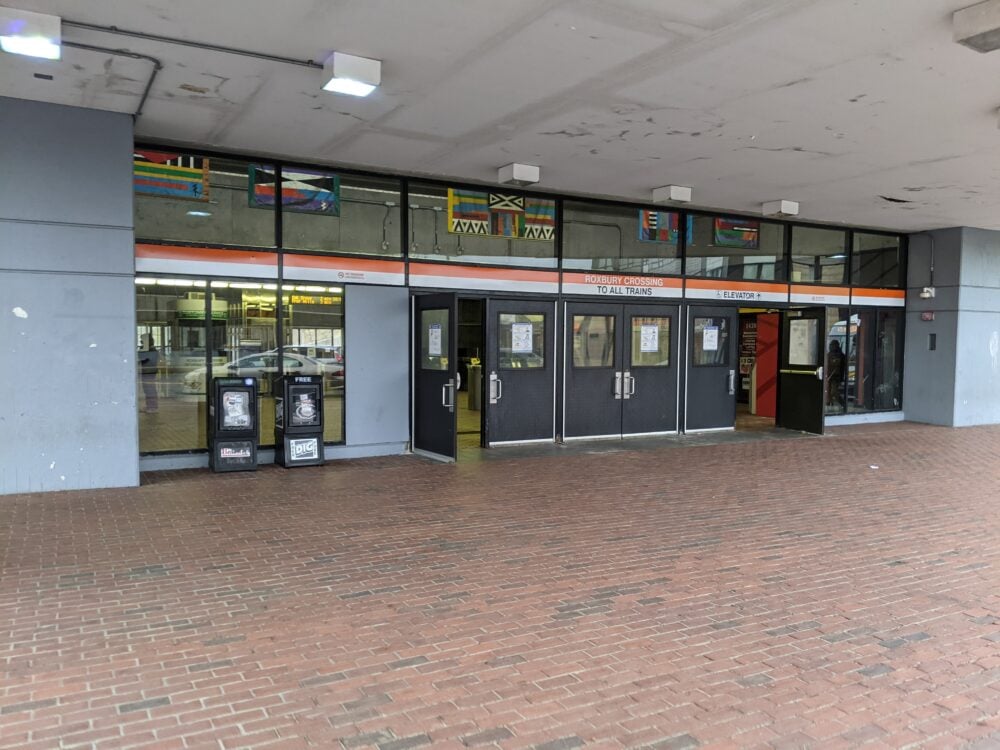
the Domino’s is just out of frame to the left
CJ: It’s 1011 and we get on the Orange Line outbound towards Forest Hills. It took two minutes for the train to arrive, and when we got on, it was really empty.
Alan: The journey down to Forest Hills is pretty smooth, save for some jolts at Green St.09 CJ: Insert classic joke about Green Station being on the Orange Line. Given this morning’s events, every jolt and stop concerns us—but the train continues on its merry way.
CJ: Told you we used up our bad luck. I said that and then Alan knocked on the walls of the train, which were patterned with wood. They probably weren’t actually wood, because we ended up getting bad luck later anyway.
Alan: At Forest Hills, we walk off our train, walk across the platform, sit down, and the doors close. Quick as that. One of the smoothest transfers I’ve ever had on the MBTA. We then got to sit and ride the Orange Line all the way back up the line.
CJ: Along the way, we talked about the names of the smart cards for other metro rail systems. I mentioned that Hong Kong had the Octopus card, New York had the MetroCard, and the Philippines had the Beep card. The CharlieCard was a way, way better name than any of these. It’s known that the card takes its name from Charlie on the MTA, a fictional character talked about in the song MTA, back when that was the MBTA’s name. But then we wondered why that guy was named Charlie in the first place.
Alan: We speculate—though with zero historical research—that perhaps he is named after the Charles River. A similar conundrum comes up with Assembly station, which we pass on our way to Oak Grove. Why is it called Assembly station? Did people assemble there? Is it named after the class of low-level programming languages?
CJ: We learned that night from Shuli that it’s actually named for the nearby Assembly Square, which is a much more reasonable name for a square than it is for a station. You know, kinda like people assembling together, rather than an assembly line. But then it turns out the square is named after a Ford Motor assembly plant that used to exist there.10 Alan: The assembly plant closed after the failure of the Edsel, which is mentioned in the song <i>We Didn’t Start the Fire</i>.
Alan: Anyways!
CJ: We arrived at Oak Grove, 1107.
Alan: This was the end of the Orange Line, and therefore also the first full MBTA line we had finished! I ate an orange to celebrate.11 as Joanne says to Maureen in <i>Rent</i>, ‘you dressed up as a groundhog to protest the groundbreaking...less than brilliant.’
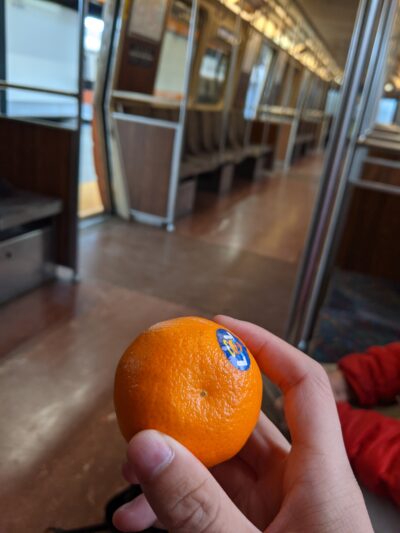
CJ: It takes five minutes for the train to leave, so I also took some time to eat snacks. We then took the Orange Line back down to Community College, where we then ran to Lechmere.
Alan: Community College station is named after Bunker Hill Community College, as seen in the film Good Will Hunting. Sadly, our run to Lechmere goes away from the community college, across a bridge on the side of a very loud road.
in the stomach of the metal octopus: all of the green line
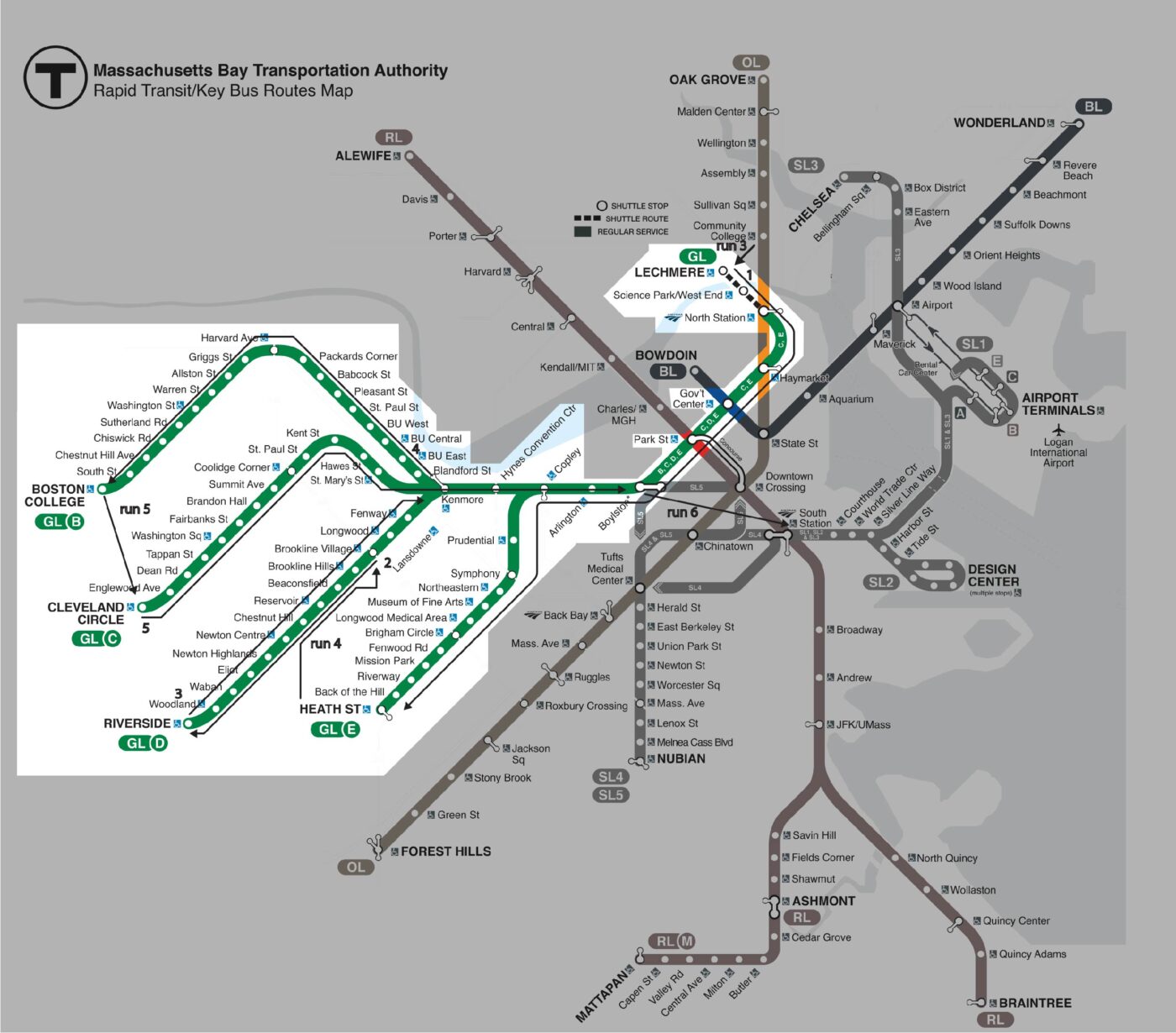
CJ: Along the way, we spot the construction going on for GLX, the Green Line Extension project. It seemed like some pretty heavy construction; they closed down the railway track along the several bridges it stood on. We arrived at Lechmere by 1138.
Alan: This means that we get to take a bustitution to North Station, since Lechmere is still officially on the map. 12 obligatory MBTA lore: GLX has been promised legally since 1990 because of the Clean Air Act and it will be completed, still with some asterisks, in 2021
CJ: I’m still so, so surprised that’s a real word. Along the way, we wonder if the shuttle is slower than the actual Green Line. The answer: probably, but not by a lot.
Alan: North Station. 11:48 AM. We are now over four hours in. But now we get to tackle the real beast—the Green Line—starting with the E branch, which runs to Heath Street. God, we have to talk about the Green Line.
CJ: At North Station, I go to the restroom, and then we take the train to Heath Street. Along the way, we talked about why the lines of the T have their colors. Green Line is named after the Emerald Necklace, the Blue Line is named from the color of the ocean, the Red Line is named after the colors of Harvard, and Orange Line was just chosen because the four colors worked well together. When I initially mentioned this to Alan, he was kinda miffed by the fact that the Red Line was named red after Harvard, as opposed to, I don’t know, red for MIT?
Alan: The Green Line E branch happened to be the only portion of journey where the streetcars run in the middle of the road, sharing lanes with cars. You’d think that this would have slowed us down, and in a way it did, but the Green Line is not necessarily known for speed. On our way out, while we were still underground, we passed Boylston Station and another “Your Speed” sign, which this time read six, i.e. six miles per hour, or a 10-minute mile, a pace even I can run.
CJ: Although I have seething hate for how slow the Green Line is, one of the few things I like about the Green Line are the voice announcements. There’s this tweet I love that’s a very good representation of what it sounds like. I swear I repeated this to Alan like five times and he wasn’t amused for any of those, but I kept doing it anyway.
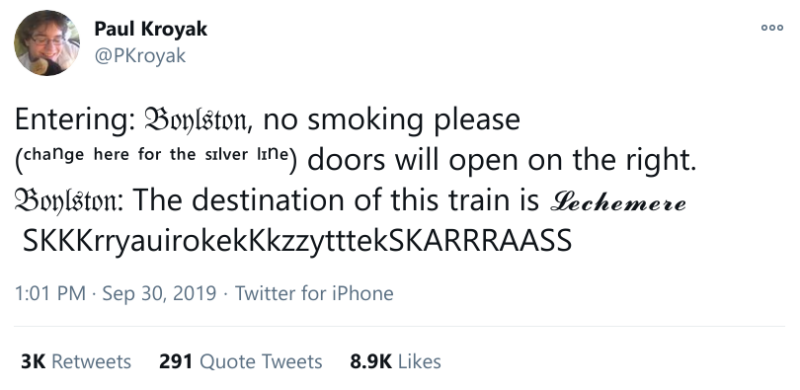
Alan: The Green Line E runs through Northeastern, whose motto is “Lux, Veritas, Virtus.”13 CJ: Note that Harvard’s motto is Veritas, and Yale’s motto is Lux et Veritas. This resulted in the following joke: Lux!
CJ: Veritas!
Alan: And Virtus! The Schuyler Sisters.14 this is the second musical reference in this post and neither of them have been good. The point of this section is that neither of us are funny.
CJ: Anyway! The train turned around at Heath Street, and we weren’t sure whether or not to stay on or get off. Our plan said we needed to run to Brookline Village, on the Green Line D, but if we took the train two stops back the run would be shorter.
Alan: The station at Heath Street is a balloon loop, meaning that the train turns around almost immediately upon stopping there. We got off, looked up, saw that the train was going to leave in one minute, got back on, and then headed two stops up. We requested a stop at Riverway and the train stopped, but the door didn’t open.
CJ: It turns out that we were stopping wrong, and in fact, for the Green Line E specifically, we needed to get off from the front of the train, because we shared the line with a bunch of cars. Which, I guess, makes sense, because we were getting off in literally the middle of the street, and the front doors of the Green Line trains had large red stop posters on them.
Alan: We end up getting off at Mission Hill, and the driver yells at us to “hurry up” as we leave, since we clearly do not know what we are doing. A little miffed, we run to Brookline Village after this, crossing the Emerald Necklace as we go. As we get there, we see the next train to Riverside pull out of the station. We’d missed it by like 40–50 seconds.
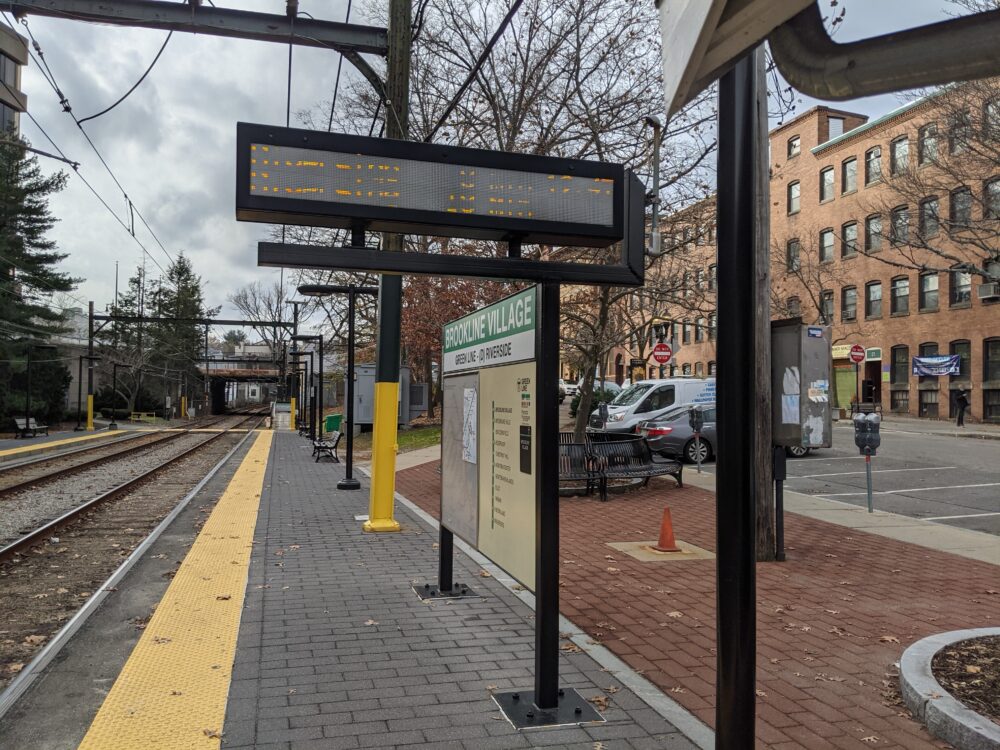
CJ: Time check: 1246. One thing you’ll notice about this picture at Brookline Village is that the sign in this picture only has a stripe of orange dots, rather than actual words. So the sign here is actually saying that the next train to Riverside is 8 minutes away. We found out in our journey that many of the T’s displays are like this, and refresh from top to bottom slow enough to be caught on camera. That meant that on the Green Line, when the words on these signs ticked from right to left, it gave the illusion that the words were italicized, when they really weren’t.
CJ: Also there was this really old poster that I wanted to show you. It has the iPhone 4! And there’s also an excellent photo of Alan, because we haven’t had enough photos of Alan in this post yet.
Alan: Green Line D branch next! This branch is the longest by far, and terminates at Riverside, named so because it is near the Charles River. We got off at Riverside at 1:19 PM, and got on another train that left around 1:24 PM.
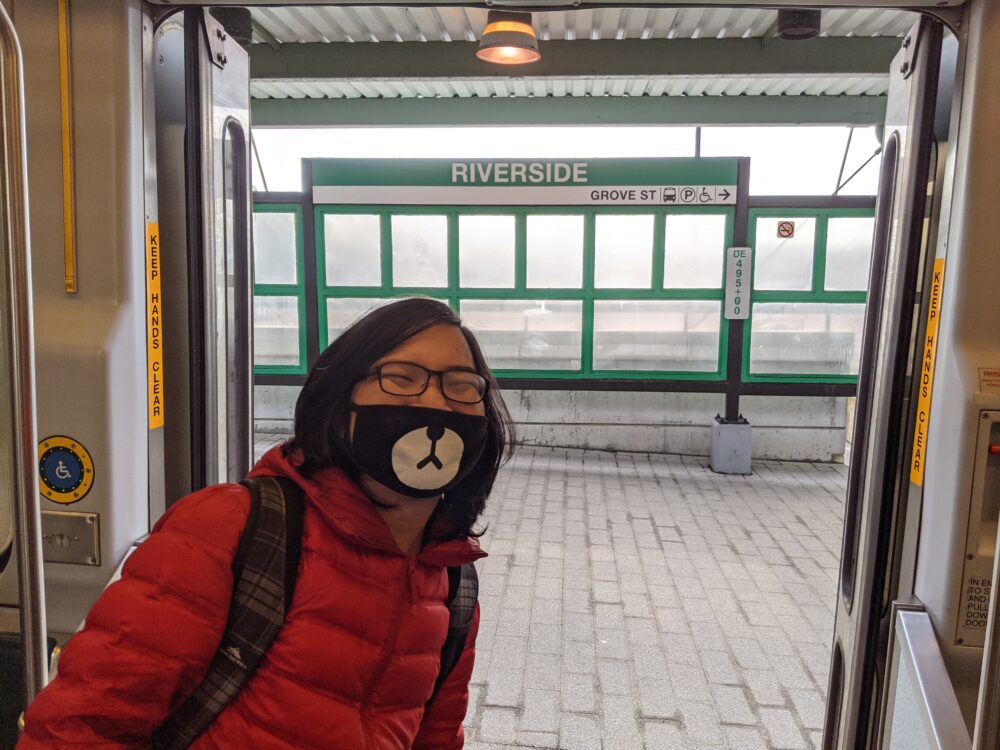
everybody say hi to CJ
CJ: My notes for this part of the route said we talked about The Most Unwanted Song. We sang some parts of that song together.
Alan: You haven’t lived if you haven’t heard an operatic soprano sing cowboy tunes and rap.
CJ: Personally, my favorite parts of the song were the kids. Any parts with the kids singing, really.
Alan: Anyways.15 at this point, this should be the title of this post We head back up the D branch to Kenmore, where the B, C, and D branches of the Green Line split.
CJ: In one of the stations heading back up to Kenmore, we saw this cool sign about Charlie on the MTA, explaining some of the history behind the song. The summary is that Charlie gets stuck on the MTA because he didn’t have enough money to pay the exit fare. The song goes on to say that every day Charlie’s wife hands him a sandwich because he’s stranded on the train. One wonders why his wife didn’t hand him enough money to pay the exit fare.16 Alan: it’s because Charlie’s wife secretly doesn’t want him home either /s
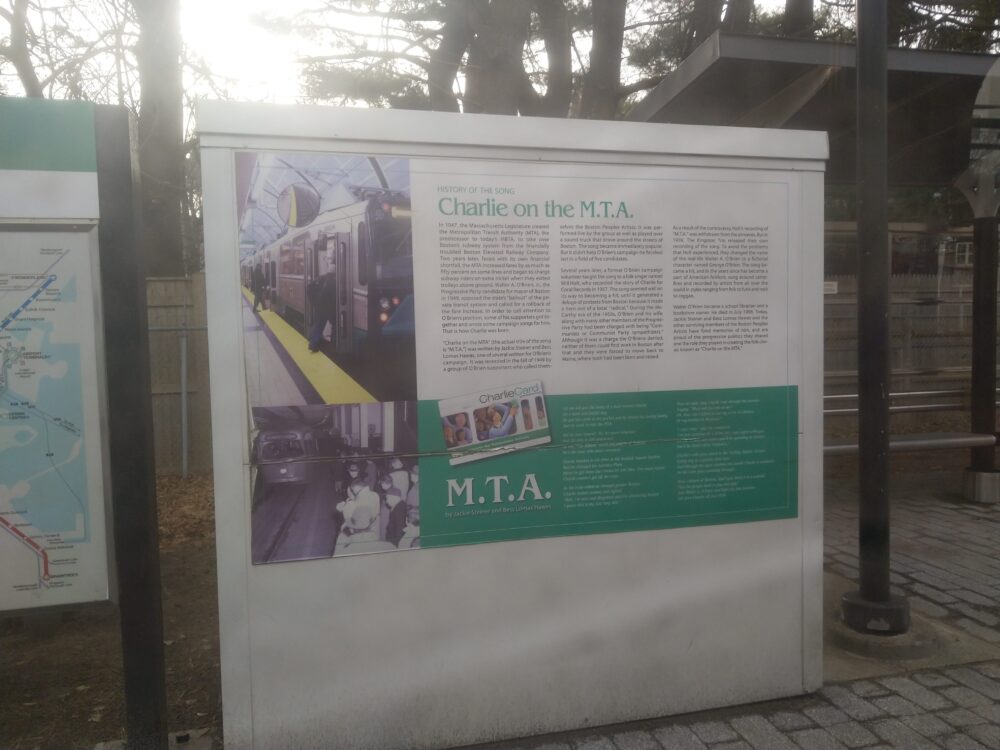
Alan: Since this is also just generally a fairly long portion of the Green Line, perhaps we will take a brief intermission here to talk about the spreadsheet, which consists of multiple sheets, each with a list of all the stations we needed to visit, an associated time column that I filled out at every stop we made, and some spreadsheet formulas with estimated and actual times. I added the two summary sheets after the journey, fortunately.
CJ: Overkill. Told you so.
Alan: It’s nice to have. In any case, it takes half an hour to get from Riverside to Kenmore, and our plan says to take the next train that arrives going to Boston College or Cleveland Circle. At this point, we are six hours deep into our journey and getting tired.
CJ: The next train pretty much came immediately, and it was headed toward Boston College. So we got on. Another really smooth train transfer.
Alan: The trip to Boston College was mostly unremarkable—except! At the very last moment, as we’re waiting to pull into Boston College station, we stop. And we wait.
CJ: And a few minutes in, the driver announces that they were waiting for a disabled train.
Alan: Disabled Train 2: Electric Boogaloo!
CJ: What joy, what luck.
Alan: We eventually get off, and, after a fairly slow transfer at BC, take a B branch train a few stops back into town, where we witness someone yell ‘Back door’ to get the back doors to open on the train. It turns out that this, too, was a possible solution to our problems on the E train.
CJ: I think it was only because the train wasn’t stopping in literally the middle of the street with dozens of cars passing by on both sides. Green Line E feels.
Alan: We get off at Chestnut Hill Avenue, just two stops up the road, and then book it down to the Green Line C.
CJ: Along the way, we saw a train going from Cleveland Circle to Chestnut Hill. Note that this was a Green Line train going from the end of the C line to a station on the B line. It was at this point that we talked about how complicated the Green Line must actually be, and how the trains were being shuttled between stations and such. Must be fun to be an operator.
Alan: The MBTA is actually working on improving this as part of its Green Line Transformation initiative! We make it down to Cleveland Circle at 2:52 PM, which sits next to a reservoir of Green Line trains. (This is also adjacent to Reservoir station, on the D branch, which is named after the unrelated Chestnut Hill Reservoir.)
CJ: Alan ate a green cookie to celebrate starting the last Green Line branch. Well-deserved, really.
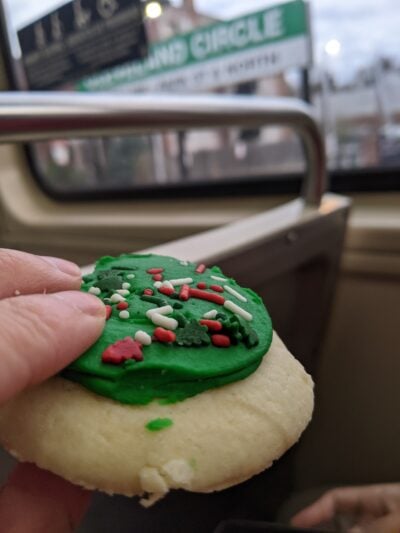
these cookies are probably very bad for you but alas
Alan: Delicious, delicious success.
CJ: See, now you’re the one jinxing it. Along the way, Alan also spots a Dunkin coffee cup taped to one of the tunnel walls.
Alan: The Dunkin coffee cup is really a metaphor for the Boston experience or something.
and the logan airport rental car center: sl2, sl3, and airport loop
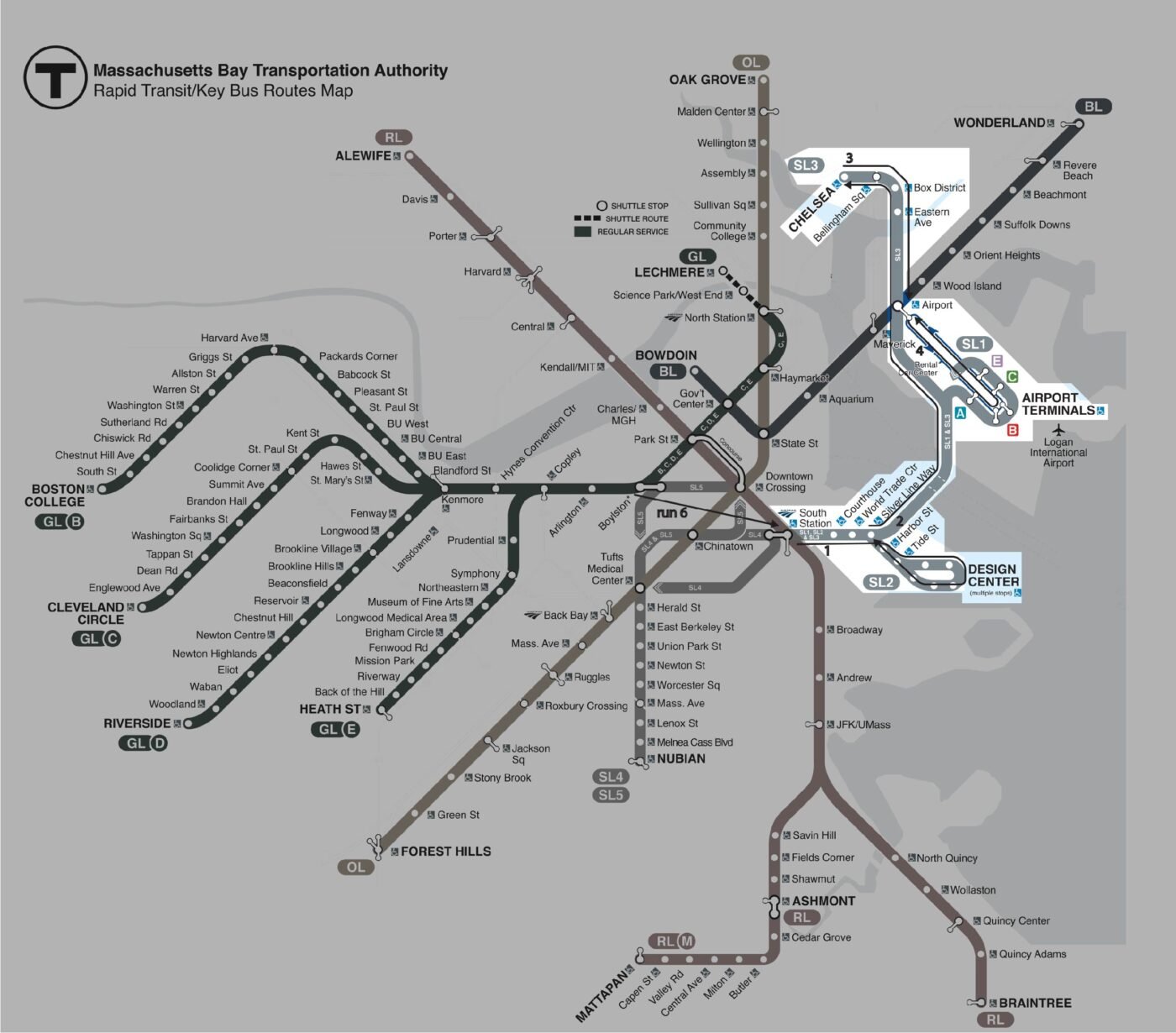
CJ: It’s 1523 at Boylston, almost eight hours since our time officially started. This also means we spent four hours on the infuriatingly slow Green Line.
Alan: I never want to see another Green Line train in my life.
CJ: Despite all of my fond memories of the Green Line, I might have to agree. We headed up and out of the station, and ran our way downtown through South Station. Interestingly enough, I think this is our only run that’s in downtown. In fact, we only visit the hub stations Park Street and South Station once in our route.
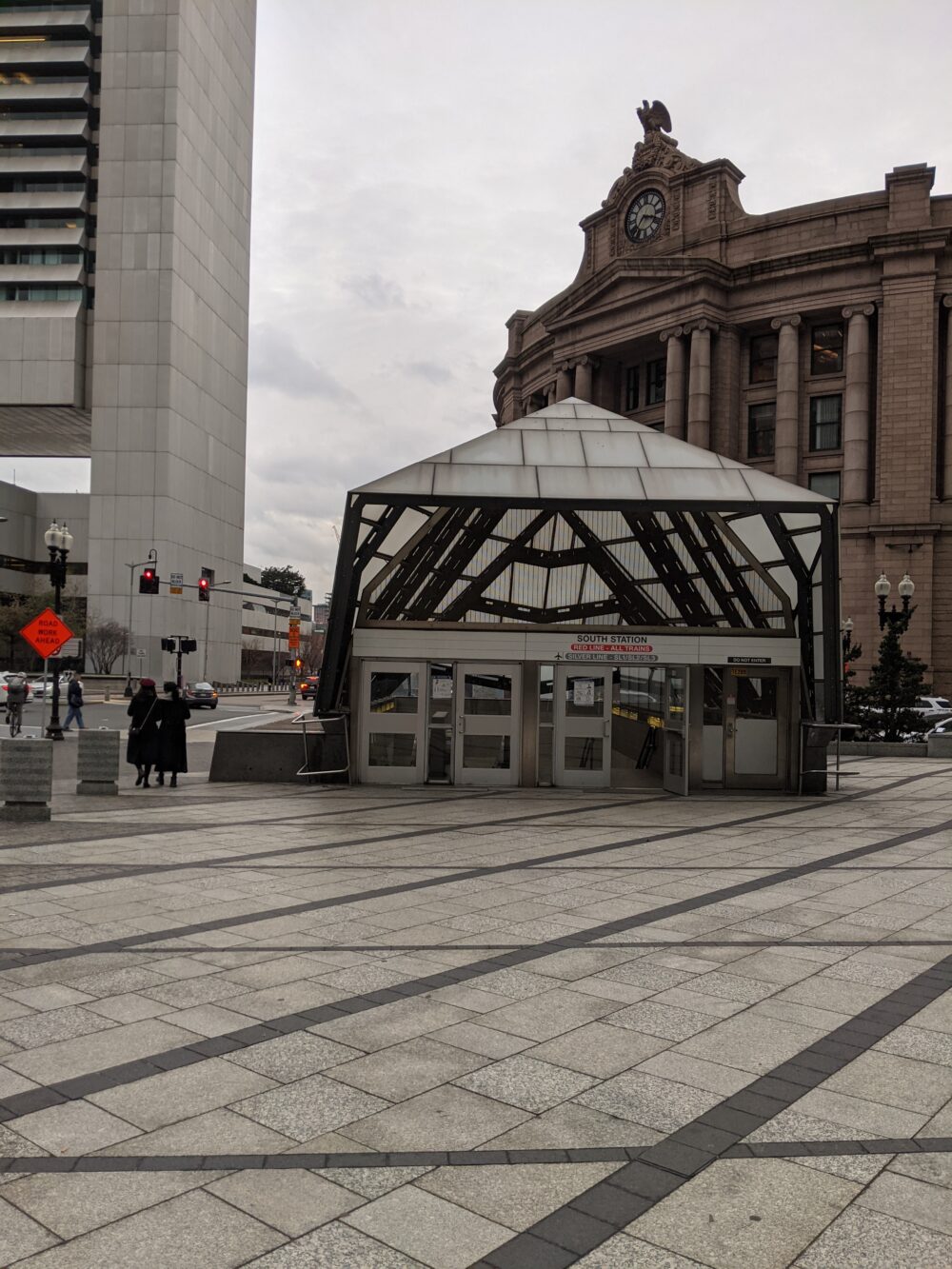
Alan: Not only that, we only visit South Station on the Silver Line, even though it’s primarily used as a Red Line station, and to get to MIT from the airport (for free!). We are not visiting the airport quite yet though—instead, our first destination on the Silver Line is the Design Center, on SL2.
CJ: The Design Center actually looks pretty cool. We should visit some time. Same thing with the Museum of Science. Also, I’m actually surprised we didn’t get any questions from the driver, considering that we just sat on the SL2 bus all the way around the loop.
Alan: You know, deep down, he was judging us. Silently. Fortunately, there was at least one other soul on the bus with us. Other shenanigans occurred with some of the stations that are technically on ‘Detour’ on the MBTA website, but were still announced by the bus’s audio system. In any case, we made it out of that area alive and without having to interact with the driver, which is great.
CJ: We get off the loop at Silver Line Way. It’s 1602, and the sun’s beginning to set. I hate how early the sun sets in winter. We were now waiting for either an SL1 bus or an SL3 bus, whichever would come first.
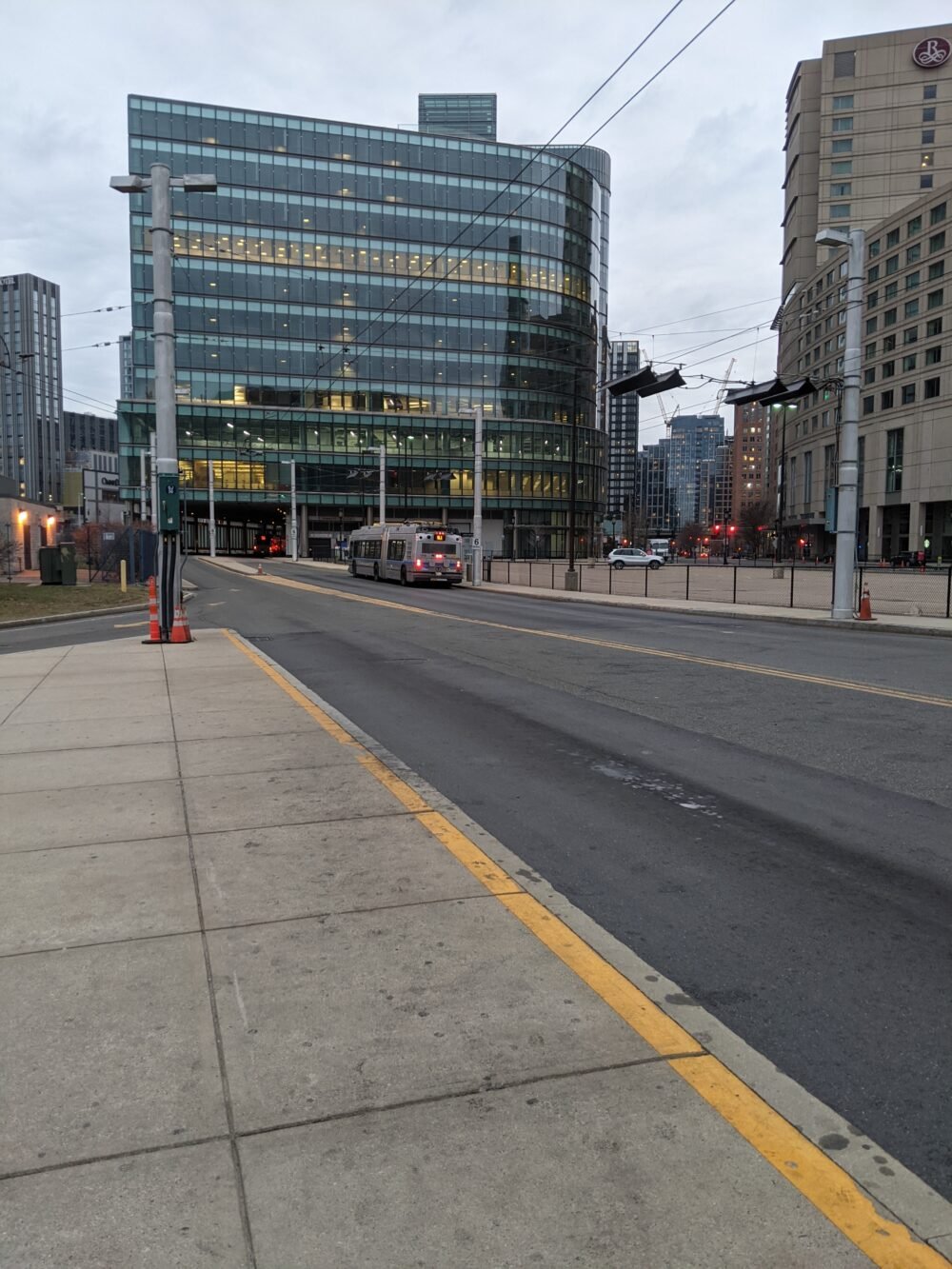
Alan: Silver Line Way is where Silver Line buses change from being electric powered to diesel powered or vice versa, with the following announcement on SL1: “At Silver Line Way, you will hear the bus’s engines shut off for just a moment, while it converts to diesel power for the rest of the trip to Logan Airport.” This deserves to be a copypasta.
CJ: Love that recording. Unfortunately, since we never took the SL1 bus through Silver Line Way, we didn’t get to hear that.
Alan: Instead, we were lucky enough to catch an SL3 bus, which took us past Airport station on the Blue Line up to Chelsea, arriving at 4:28 PM, or just under 9 hours after we’d started.
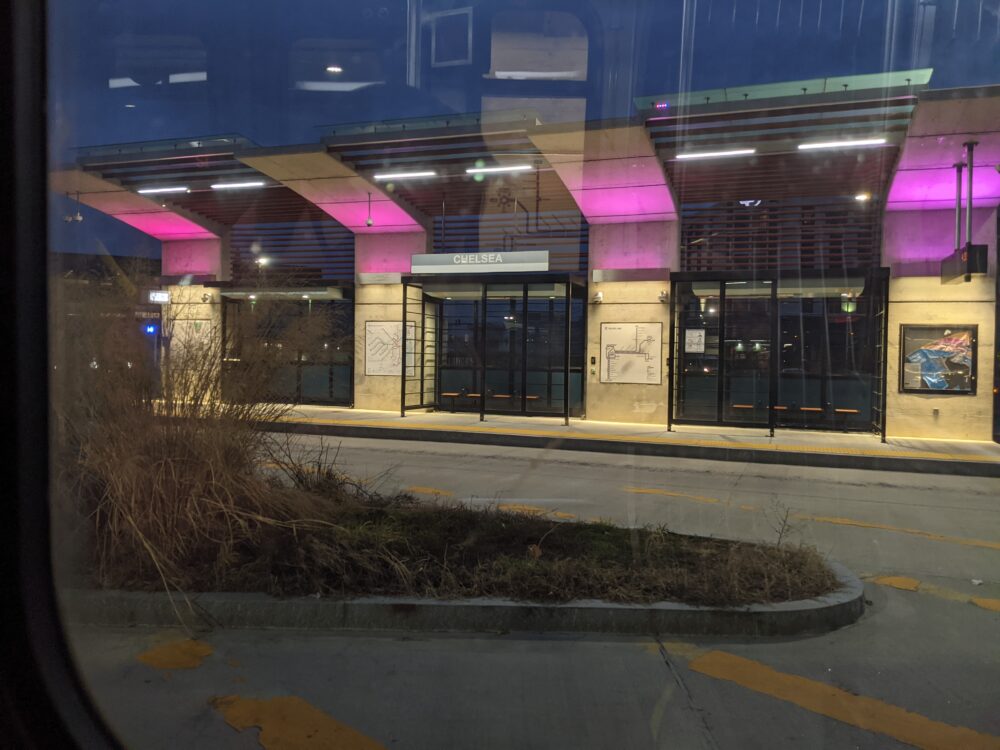
CJ: We did a quick transfer back down to Airport Station. Also, see those purple lights in the previous picture? Those actually shifted colors through the whole rainbow, so from purple, to red, to orange, and so on. When we passed by Box District, these lights were green, and I heard Alan repeat that he never wanted to see green on the MBTA for the rest of his life. I mean, sure.
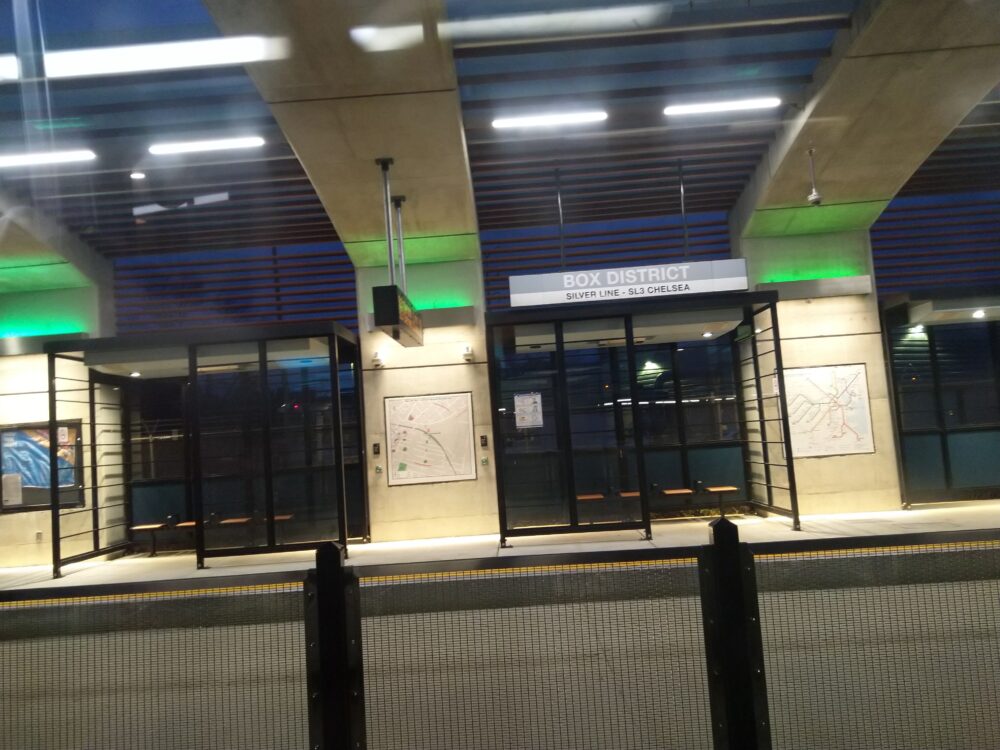
Alan: Our next destination was the airport proper, which has five stops on SL1 and the Blue Line Shuttle—Terminal A, Terminal B Stop 1, Terminal B Stop 2, Terminal C, and Terminal E. We had a bit of a struggle trying to figure out which shuttle we needed to take to get us to all of these stations, since some only stopped at terminals A and B, and others only stopped at C and E.
CJ: I think we just took the first bus we saw, a 22 bus, which went to Terminal A.
Alan: But before it went to Terminal A, we got to make our one and only stop which was not an MBTA station!
Alan and CJ (in unison): The Logan Airport Rental Car Center.
CJ: It was clear that this was the most popular stop among the airport shuttles, because pretty much everyone who was on the bus got off at the Rental Car Center. So it was just the two of us all the way to Terminal A, where we got off to transfer to another bus. A bus that would take us to all the terminals, because the bus we were on was only going to Terminal B.
Alan: This mystical bus pulled up right behind the bus we had just got off, so we hopped on it right away. We checked with the driver that this would, in fact, bring us back to Airport Station when we were done, and then we were all set.
CJ: Was it the 11? The 55?
Alan: Only God and the Massachusetts Port Authority can answer that question.
CJ: Apparently nobody else wanted to be on this bus either, because it didn’t go to the Rental Car Center. So when some people realized this, they got off the bus, leaving only me, Alan, and one other person.
Alan: The airport shuttle announcements have always been a favorite of mine. All international arrivals, for example, stop at Terminal E, meaning that every other station requires the voiceover artist to announce the list of airlines and then note this. For example: “This terminal serves Delta, Delta Shuttle, and WestJet, excluding international arrivals, which arrive at Terminal E.” The list of airlines is also really long for Terminal E, since it’s literally every international airline.
CJ: Anyway! We arrived at Airport Station on the Blue Line at 1708, for the third time.
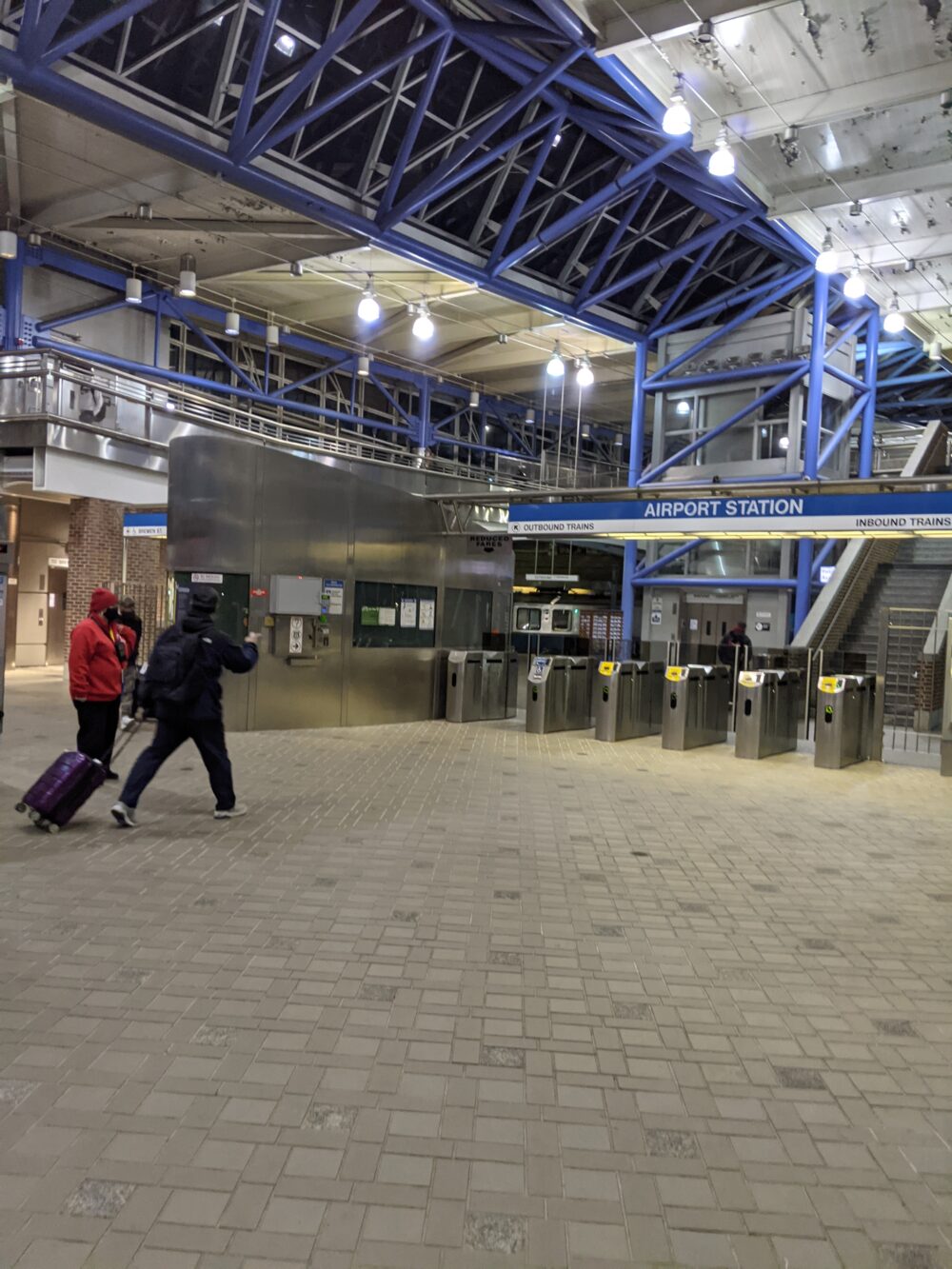
the home stretch: blue line and red line, part two
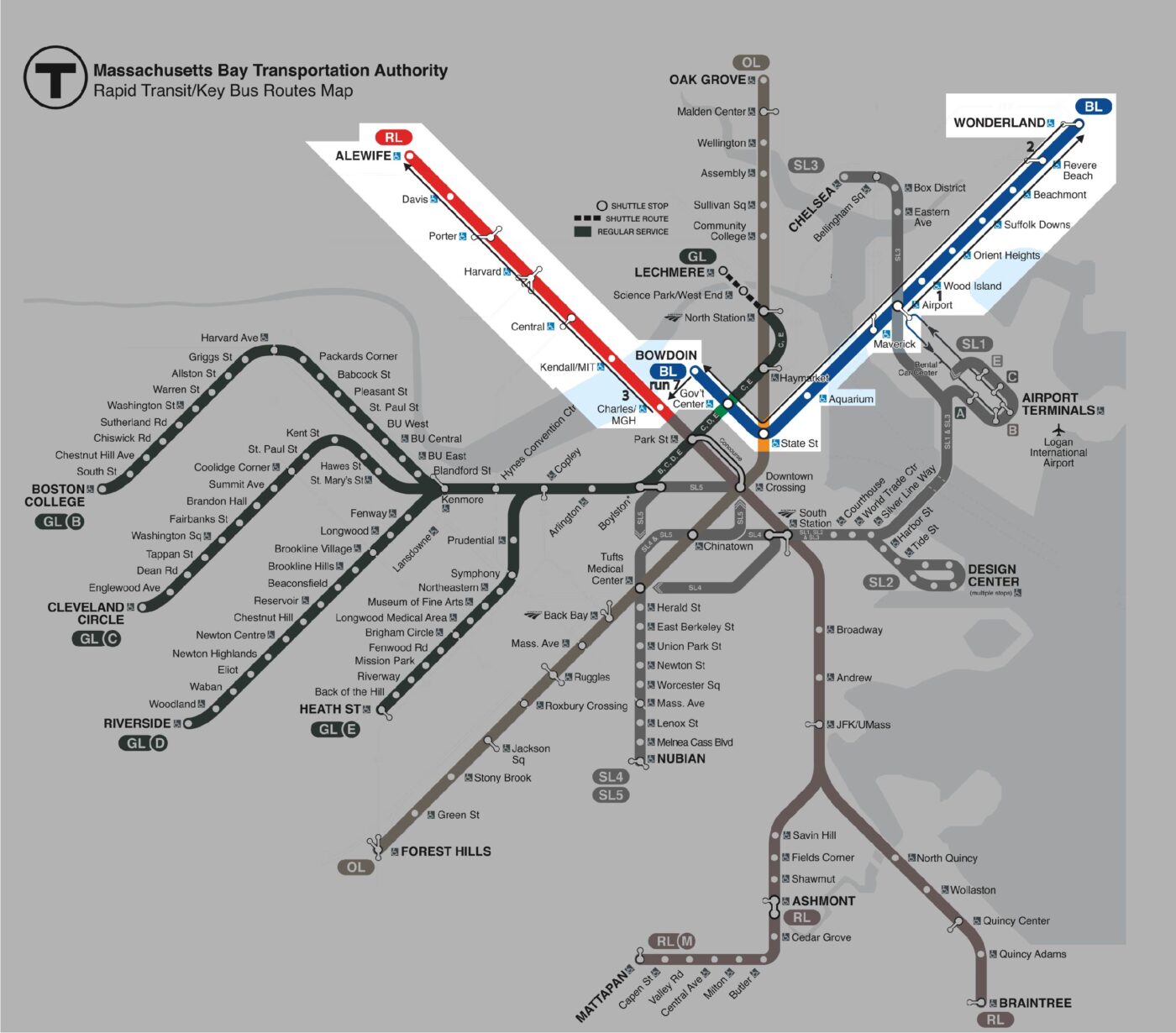
Alan: Finally, we can get on the Blue Line. We take the train out towards Wonderland, a station named after an amusement park that no longer exists. The sun has set completely by now, and it is very, very dark.
CJ: As soon as we get off the train in Wonderland, we miss a train headed back in the other direction. Not too big of a deal, though, since the next train was leaving in 5 minutes.
Alan: Also, at this point, we’re kind of tired and the rush no longer has any meaning to us. We get on the next train and take it back down to Bowdoin, passing Airport station for the fourth time along the way at the ten hour mark of our journey.
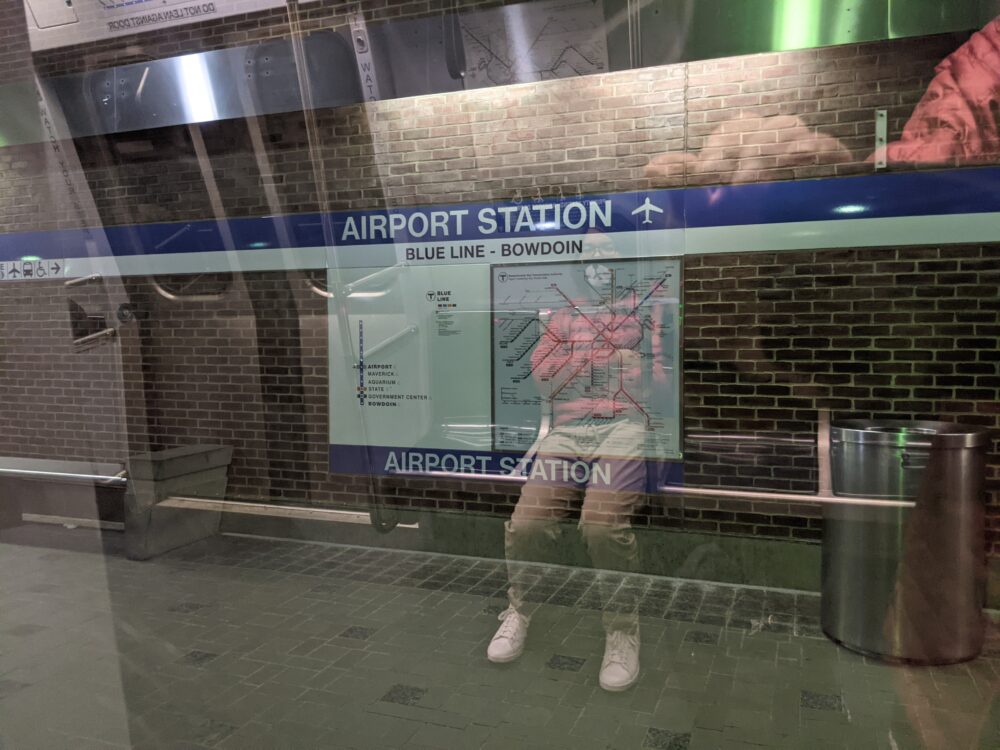
ft. a reflection of CJ and my hand holding the camera
CJ: This was the home stretch! After this, there was just the second half of the Red Line.
Alan: We get to Bowdoin at 5:46 PM.
CJ: Then we run, run, run to Charles/MGH. I smelled food. I was getting hungry.
Alan: Getting to Charles/MGH felt like getting back onto home turf. The station is right across the Longfellow Bridge from MIT. It was…so nice to see it again, and to know that there would be no transfers after this.
CJ: I had never been so glad to see Charles/MGH in my entire life. The next train would arrive in six minutes, so we took a few minutes just walking around the station and looking at things.
Alan: There was a short fiction piece from the “Boston in 100 Words” contest across the track. The events it described were eerily similar to the ones which we had experienced this morning.
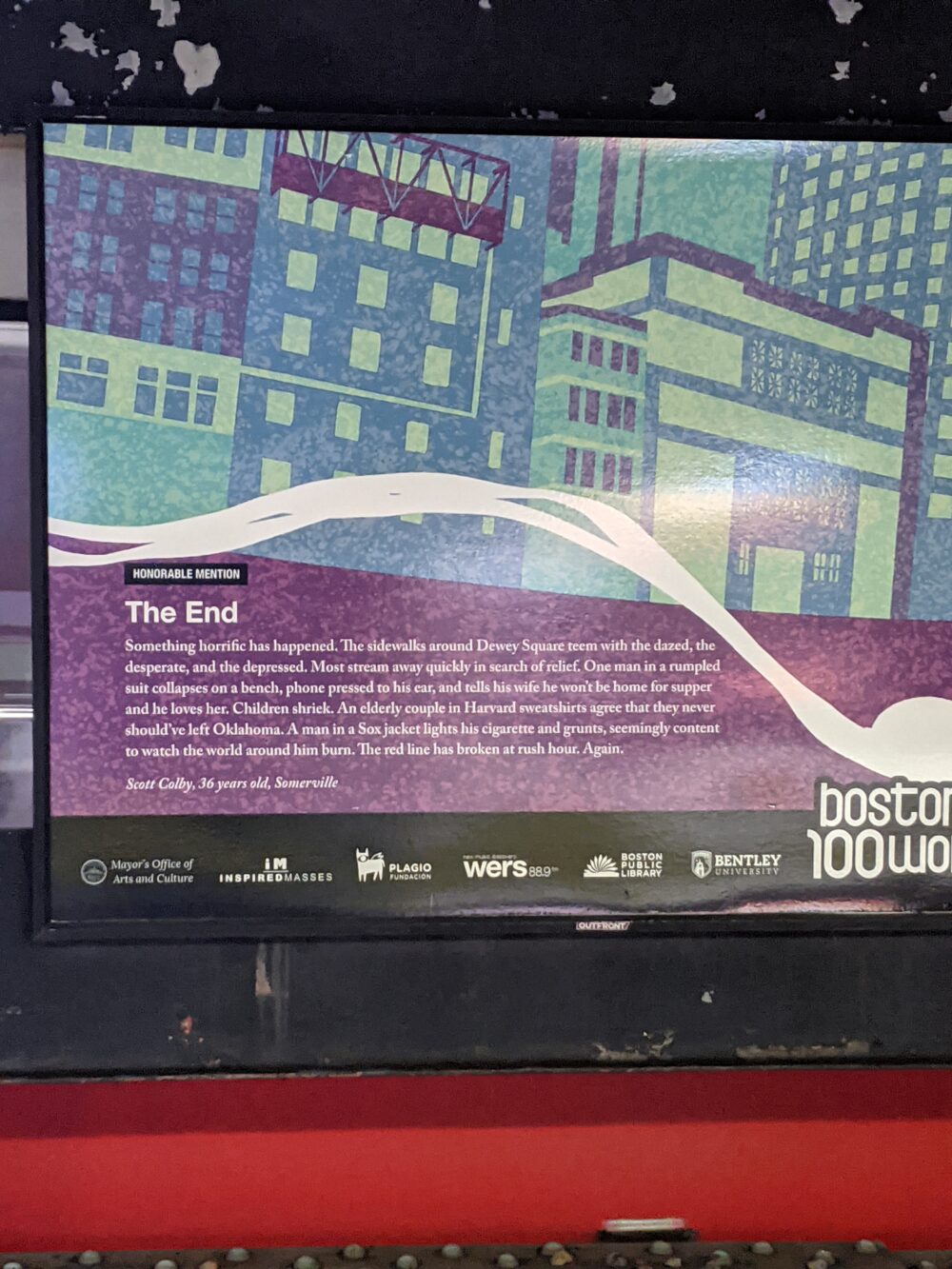
CJ: Then we got on the train to Alewife.
Alan: We passed Kendall/MIT, where we started, at 6:02 PM, just over 11 hours from when we left it. But we still had five more stations to go.
CJ: We were amused with the driver’s announcement of Harvard Station. It was something like, next stop, HahvAHHHD SKWEEEEHhh.
Alan: Like, dude, we get it, you’re from Boston. Very cool.
CJ: And finally…
Alan: Finally…Alewife!
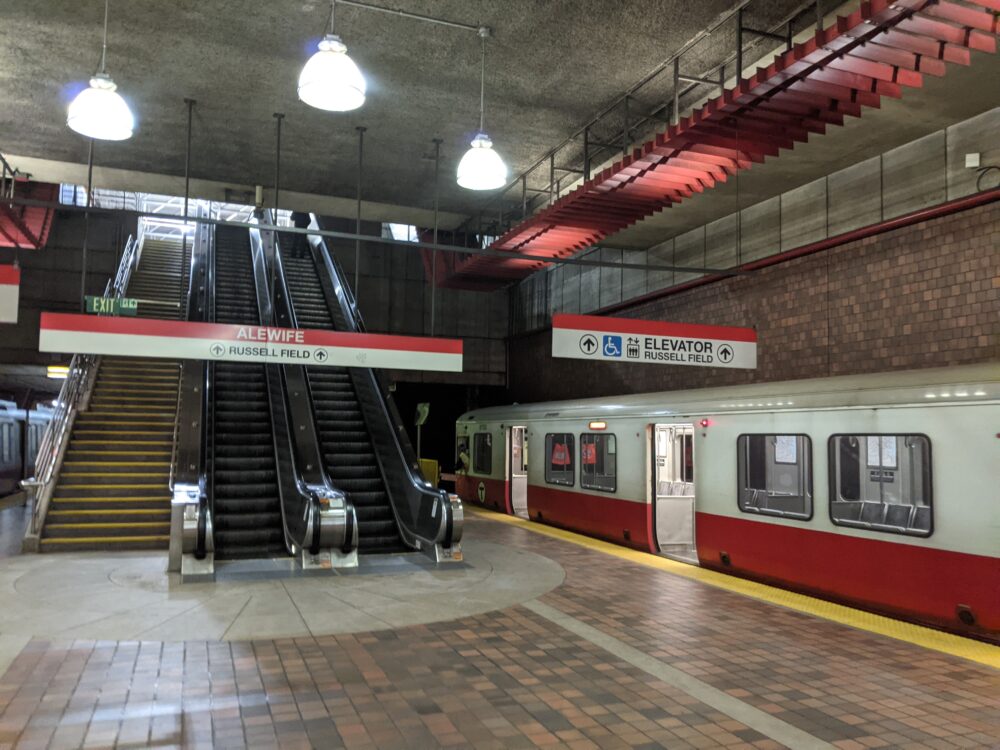
CJ: That was the last station. As soon as the train stopped moving, we stopped the timer.
Alan: 10:44:40, plus or minus a few seconds of user error.

CJ: It was now 1820. When we started, we were expecting this to take, what, seven hours? Eight hours, at worst?
Alan: I think we said that the very, very worst case was ten hours. Which we also missed.
denouement
CJ: We get off the train and… we’re done. We spent a few minutes walking around Alewife station, in a casual, relaxed manner. No more running. No more walking on the escalator. We just… went around and enjoyed the scenery and stuff.
Alan: Alewife station is very large, and very beautiful, and if we hadn’t been so tired we probably would’ve found more things to talk about there.
CJ: Instead, we talked about food.
Alan: Food! I had saved a red cookie for the end of the Red Line, but decided to save my appetite for real food. We ordered some food from Tenoch Mexican in Somerville—I got a burrito, CJ got a quesadilla.
CJ: We then took the Red Line one station down to Davis. We could’ve walked, but, you know, we had a one-day pass to the T and we were going to use it.
Alan: The station at Davis was also kind of pretty. Again, we ignored most of it. We walked down to the restaurant, where we met up with Shuli!
CJ: We talked about our journey. Shuli asked us some questions. I’m not sure I remember any of them. I was just really tired.
Alan: It also started raining at some point during this time, which was annoying, but I was mostly just glad that it hadn’t been raining while we were doing our trip.
CJ: So the three of us, Alan, Shuli and I, ate in like, this parking lot, because it was the only place we could find shade that wasn’t too sketchy. It was still sketchy, but what choice did we have?
Alan: And then we walked to Porter. We said goodbye to Shuli, and then we got on the T for the last time, all the way at the bottom of the ridiculously large escalator at Porter.
CJ: And we got off at Kendall/MIT, where our journey began fourteen hours earlier.
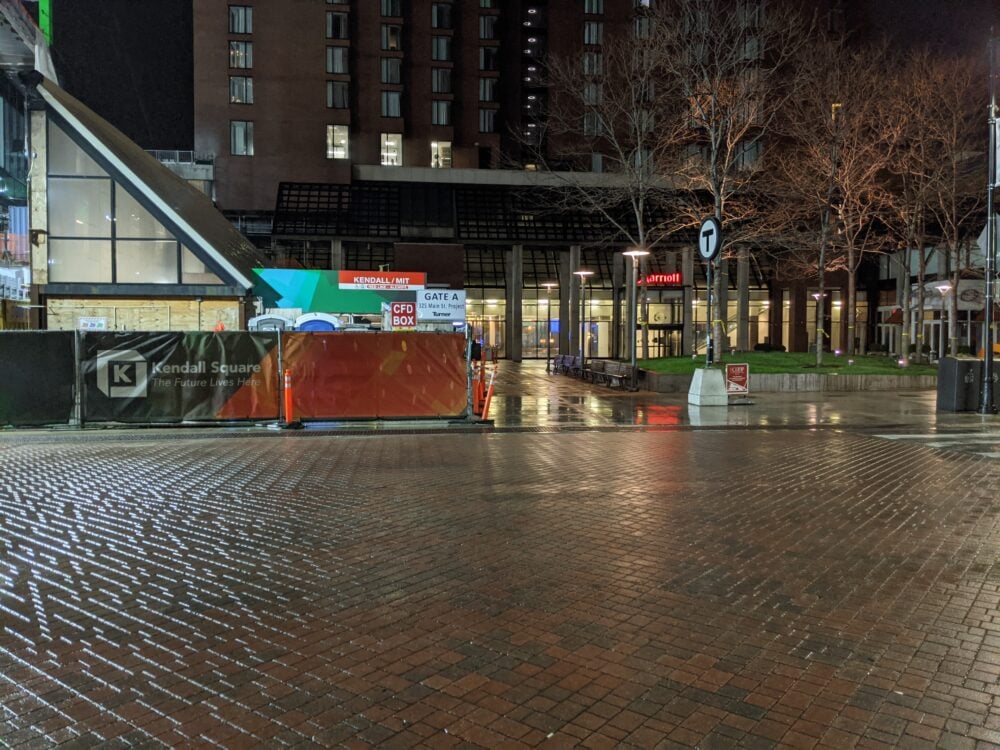
CJ: And then we walked back home. I came back to my room and my boxes finally arrived, so I spent a few minutes unpacking all my stuff before collapsing on the bed for a couple minutes.
Alan: I think I proceeded to pass out for about an hour when I got to my room, and then did nothing for the rest of the day. And by nothing, I mean that I spent like four hours looking up deep lore about the history of the MBTA.
CJ: Mood. We shared a lot of MBTA facts with each other, probably enough to make another blog post about it.
Alan: Is that foreshadowing?
CJ: I think so.
End scene.
- there is so, so much MBTA lore back to text ↑
- much more back to text ↑
- CJ: I’m gonna write things in 24-hour time for this post. Alan is using less sensible notation. (Alan: For what it’s worth, my timestamps are also in 24-hour time, I’m just writing this way in opposition to CJ’s notation.) back to text ↑
- I learned some of this in 6.854, an advanced algorithms class I’m taking that I previously talked about. (Alan: very, very slightly less than 1.5, based on recent work.) back to text ↑
- The FitnessGram™ Pacer Test is a multistage aerobic capacity test that progressively gets more difficult as it continues. back to text ↑
- CJ: Alan said he was going to add an annotation here and that everyone was going to hate it. After now reading it, I agree, I hate it. He now says he has a keyboard macro for this. Seriously, Alan? (Alan: Yes.) back to text ↑
- this originally read ‘most southern’ until CJ made fun of me for not knowing words back to text ↑
- Alan: I did not know they were called this. back to text ↑
- CJ: Insert classic joke about Green Station being on the Orange Line. back to text ↑
- Alan: The assembly plant closed after the failure of the Edsel, which is mentioned in the song We Didn’t Start the Fire. back to text ↑
- as Joanne says to Maureen in Rent, ‘you dressed up as a groundhog to protest the groundbreaking...less than brilliant.’ back to text ↑
- obligatory MBTA lore: GLX has been promised legally since 1990 because of the Clean Air Act and it will be completed, still with some asterisks, in 2021 back to text ↑
- CJ: Note that Harvard’s motto is Veritas, and Yale’s motto is Lux et Veritas. back to text ↑
- this is the second musical reference in this post and neither of them have been good. back to text ↑
- at this point, this should be the title of this post back to text ↑
- Alan: it’s because Charlie’s wife secretly doesn’t want him home either /s back to text ↑
